Dave's Travel Pages
Greek Island Hopping | Greece Travel Ideas | Bicycle Touring

Visiting Mycenae in Greece – How to see Mycenae UNESCO Site in Greece
The archaeological site of Mycenae is one of the most important in Greece. Here's how to visit Mycenae, and what to see and do when there.
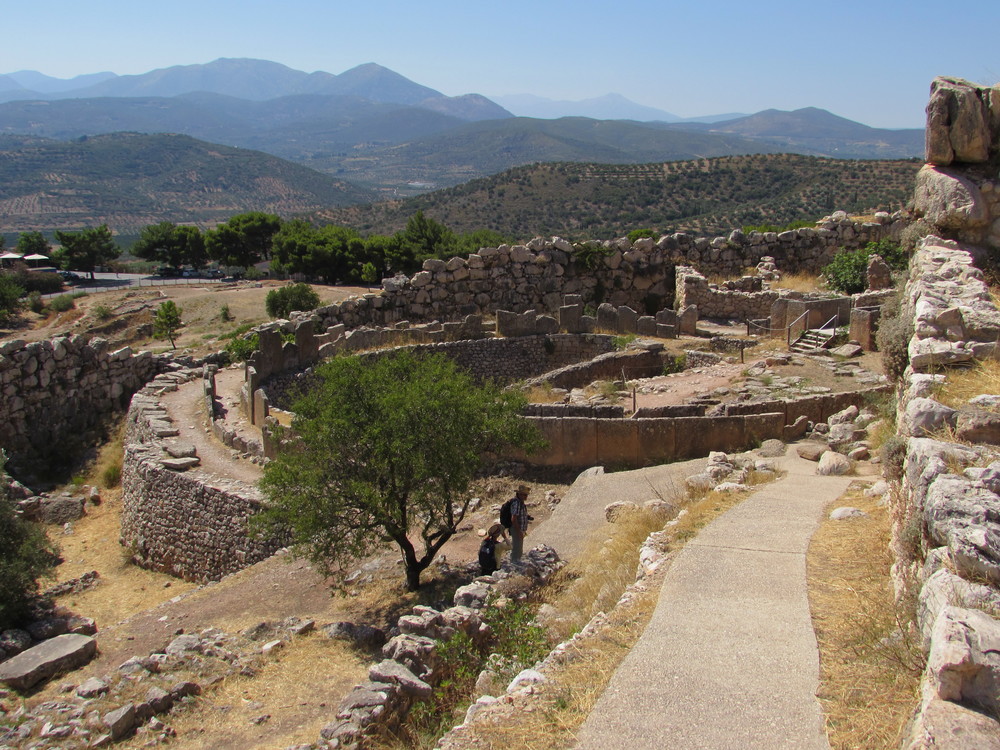
Mycenae – Myth and History combined
As a kid, I was always fascinated by myths, legends, and ancient civilizations. I read the Iliad at a young age (English translated version!), and this inspired me to visit archaeological sites when I started traveling.
Now that I actually live in Greece , I've really been able to indulge myself! There are an endless amount of archaeological sites such as Delphi , Messene , and Ancient Olympia to visit.
One important site which I've now been fortunate to have visited twice is Mycenae . It's one of my favourites, as much for its setting as the ruins themselves.
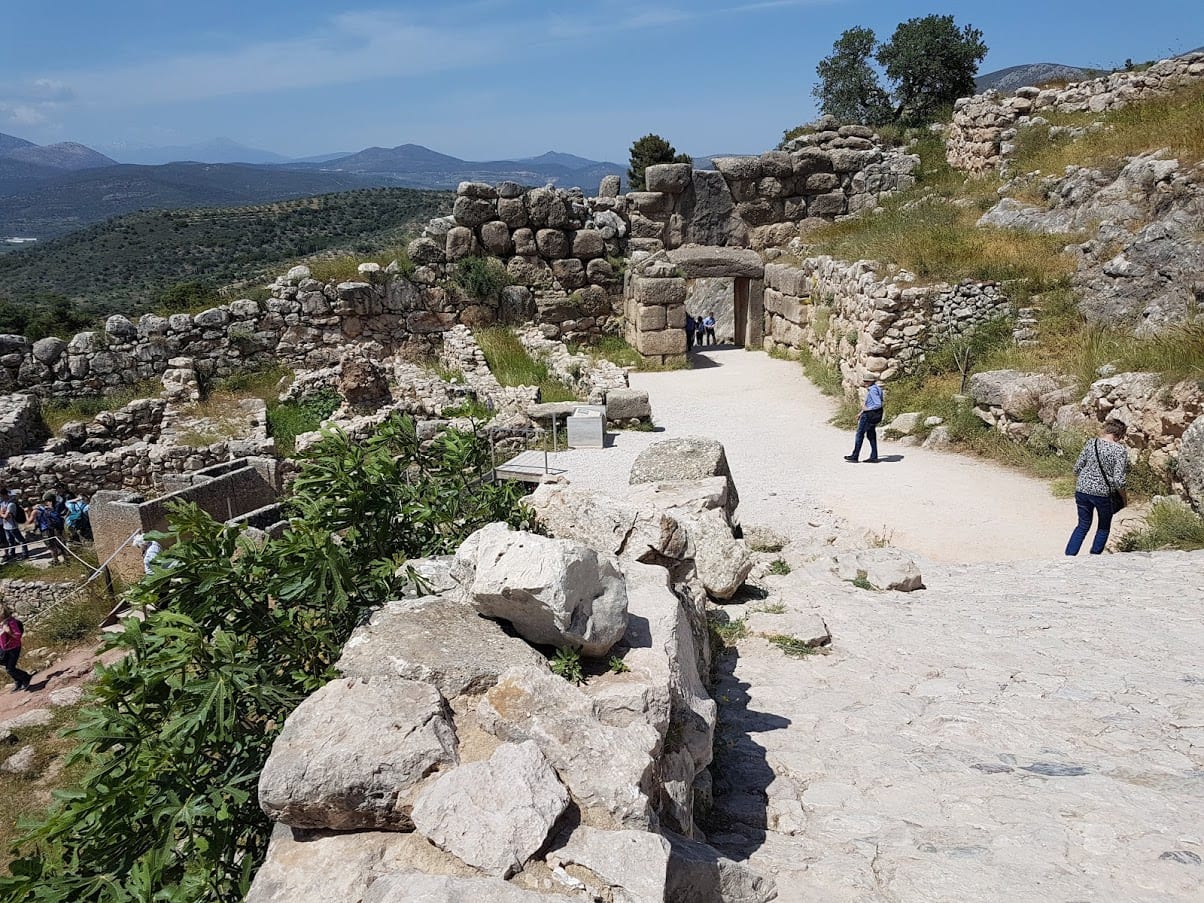
I've created this little guide on visiting Mycenae to both inspire you and help you plan to get there. If you love ancient Greek history and want to include a UNESCO site to your Greece travel itinerary, it's certainly worth considering the trip out there.
Where is Mycenae in Greece?
Mycenae is located in the north-east Peloponnese region of Greece, and is less than a two hour drive from Athens. If you do decide to drive from Athens to Mycenae, you'll pass over the impressive Corinth Canal along the way.
Many people visit Mycenae as part of a day trip from Athens , and there is a constant flow of bus tours coming and going from the site. Quite often, a day trip from Athens may combine Mycenae and Epidaurus as well as Nafplio.
For most travelers spending just a few days in Athens before going to the islands, visiting Mycenae from Athens on a guided tour is going to be the easiest option. This tour is a good choice: Full day Mycenae and Epidaurus .
It is also possible to visit Mycenae from the pretty coastal town of Nafplio in the Peloponnese if that's where you're staying. It would only take a half hour or so to drive from Nafplio to Mycenae.
I visited Mycenae slightly differently to most people. On the first occasion, it was during a road trip in the Peloponnese. On the second occasion, I cycled there as part of solo bicycle tour in the Peloponnese I based on the myth of the 12 Labours of Hercules.
If you do decide to get there under your own steam, you'll find the site is very well signposted from the roads, and there is plenty of parking once there.
Mycenae Opening Hours
When taking an organized tour to Mycenae, you don't need to worry about what time Mycenae opens. If you're visiting independently, it's probably worth double checking that the Mycenae site is open before you rock up!
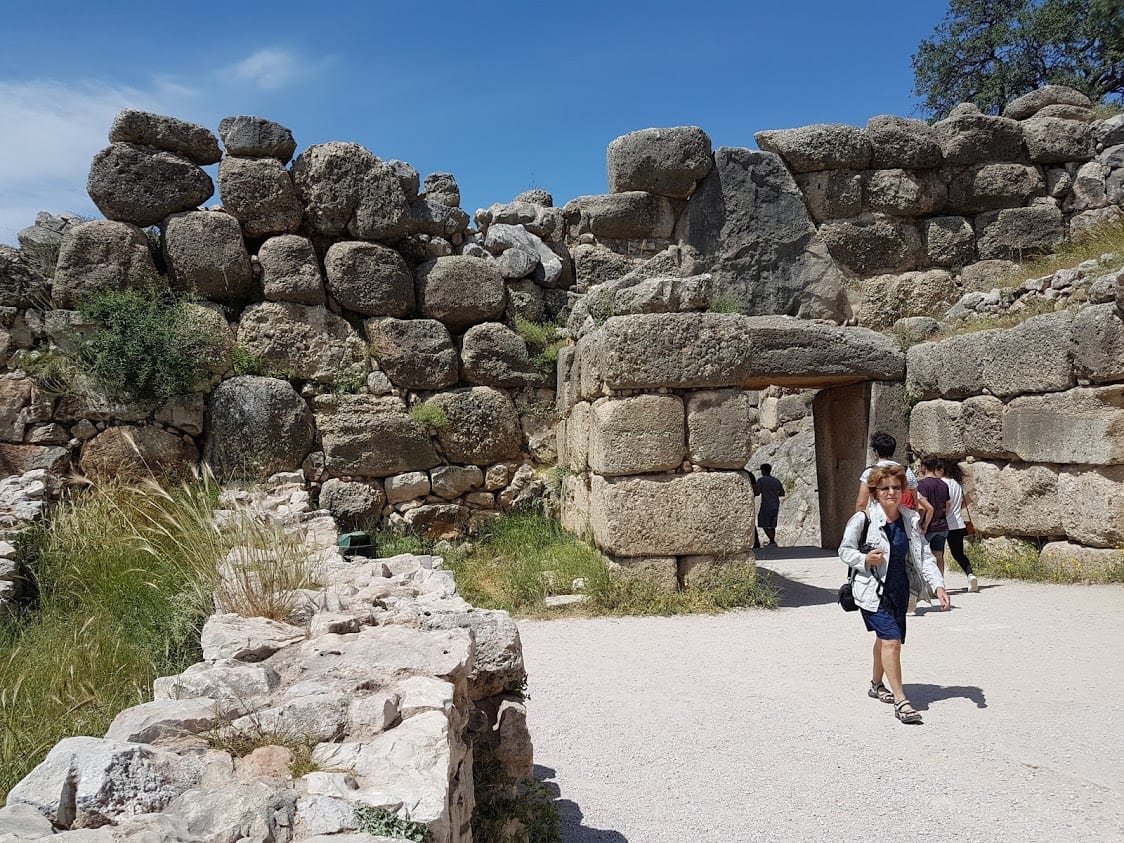
During the winter period, Mycenae is open from 8.30-15.30.
During the summer period, the hours are:
April-August: 08:00-20:00 1st September-15th September : 08:00-19:30 16th September-30th September : 08:00-19:00 1st October-15th October : 08:00-18:30 16th October-31th October : 08:00-18:00
There's all sorts of free days and holidays as well. You might find it useful to check out the official site here: Mycenae ‘Rich in Gold'
What was Mycenae?
Mycenae was a military state which rose to power after the collapse of the Minoan civilization. When you travel in Greece and hear reference to the Mycenaean civilization, this is where it began!
Dominating trade and commerce, Mycenae in effect defined ancient Greece from between 1600 to 1100BC.
In fact, this period of Greek history is named the Mycenaean age . Even so, the Mycenaean civilization and culture is a somewhat mysterious one.
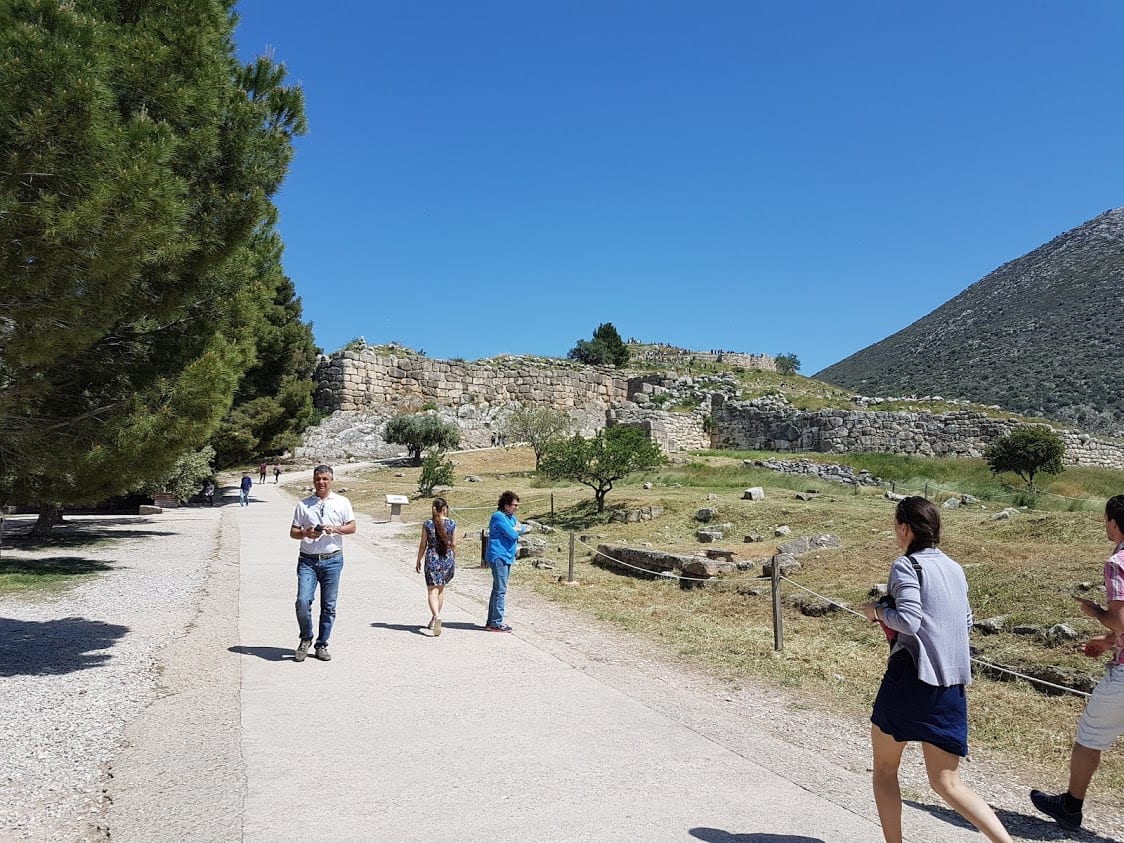
Greek Mythology and Ancient History
Most of what is known about the Mycenaeans is taken from the archaeological records, or from Homer's Epics. The latter of course was thought for many years to be just legend, until it was proven otherwise by the discovery of Troy.
Now, mythical characters such as King Agamemnon are thought to have been actual historical figures. Even the Trojan War might have taken place, and it is entirely possible that Agammenon once lived at the palace at Mycenae.
Interestingly, although a gold funerary mask was discovered at Mycenae, and is called ‘Agamemnon's Mask', there is no proof that it was actually his.

Archaeological Site of Mycenae, Greece
Today, Mycenae is a UNESCO World Heritage Site. The archaeological space contains the excavations as well as a very interesting archaeological museum.
There are several key areas to the Mycenae archaeological site you should see. These are:
- The Treasury of Atreus
- Tomb of Clytemnestra
- Circular Burial Chambers
- The Lion Gate
- Cyclopean Walls
Museum of Mycenae
- Passageway to the Cistern
Tombs of Mycenae
There are two main types of tomb at Mycenae. One is known as a Tholos type tomb, and the other simply as circular graves. The most famous of the Tholos tombs at Mycenae is the Treasury of Atreus .
Tomb of Agamemnon?

No treasure to be found there though. The site had long ago been robbed and looted of whatever may have been there. Was this the burial site for Agamemnon? We will never know for sure.
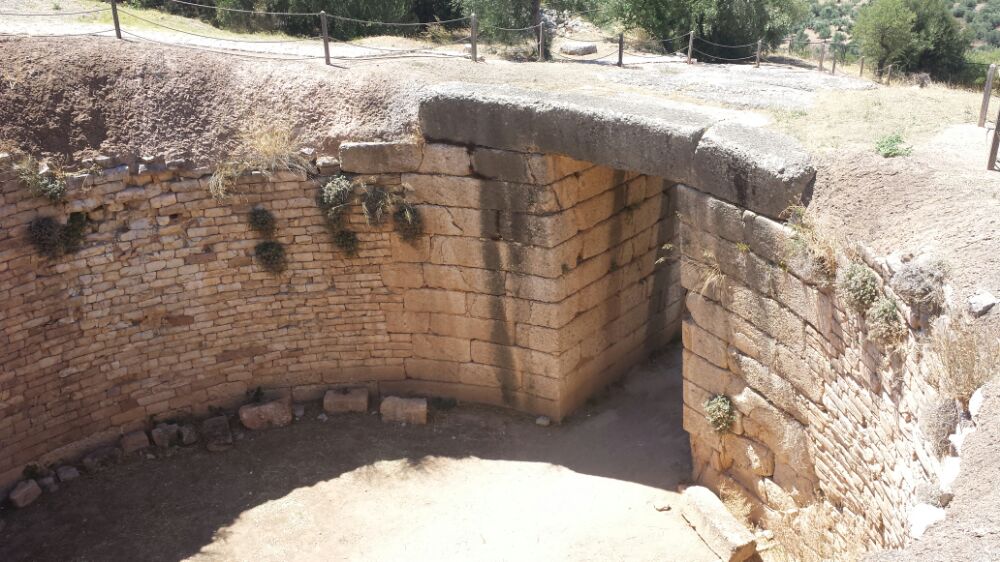
The circular chambers such as the one pictured above did actually contain the worldly possessions of the deceased. Many of these are now on display in the Mycenae Museum.
You might be in a rush to see the famous Lion Gate of Mycenae and Cyclopean Walls, but I'd suggest seeing the museum first. It's helpful in giving an overview as to how Mycenae developed over the years, along with its strategic importance.
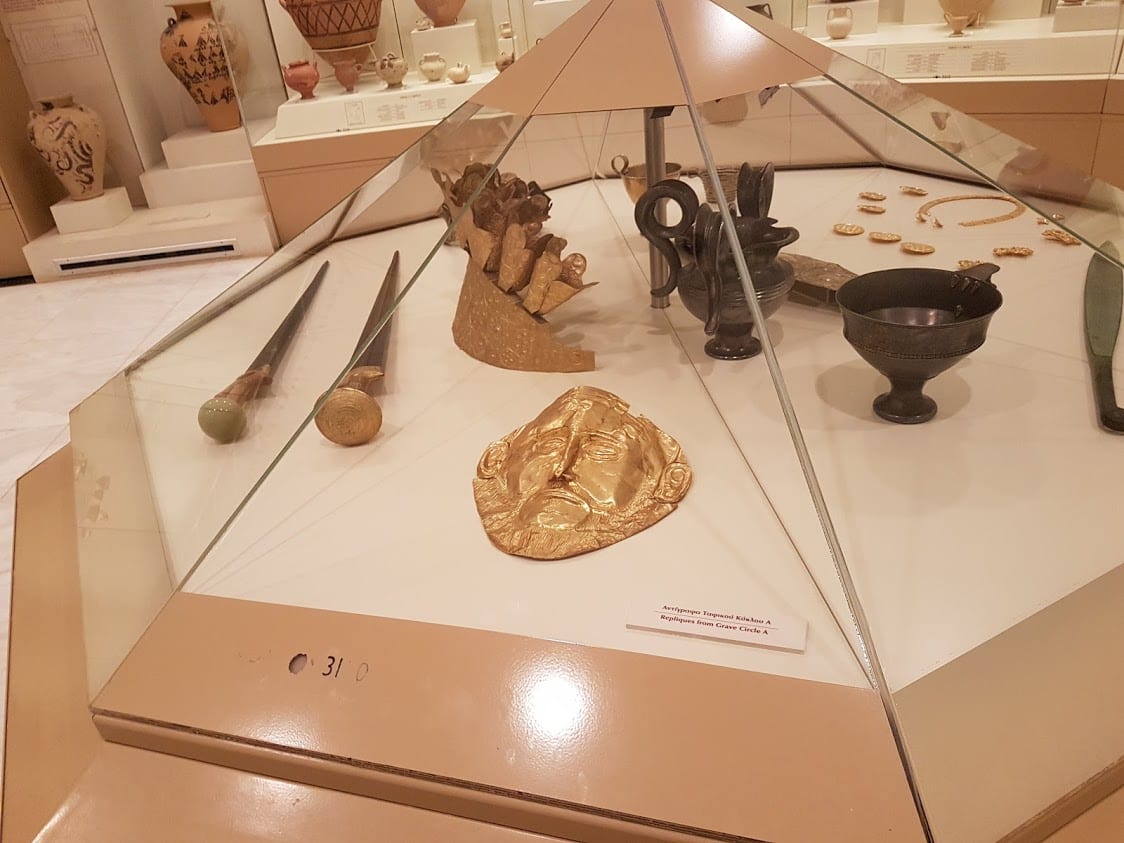
There are a number of interesting exhibits displayed in the museum, as well as a little back history as to how the site was excavated.
Heinrich Schliemann plays a brief but important role in the site's excavation. If you recognise his name, it is because he also discovered what most historians now believe is Troy.
Mycenae Palace (Citadel)
Once you've finished inside the museum, it's then on to exploring the ruins of Mycenae. Its elevated position gives it a naturally defensible advantage, and effectively what we have is a citadel with the remains of a palace at the top.
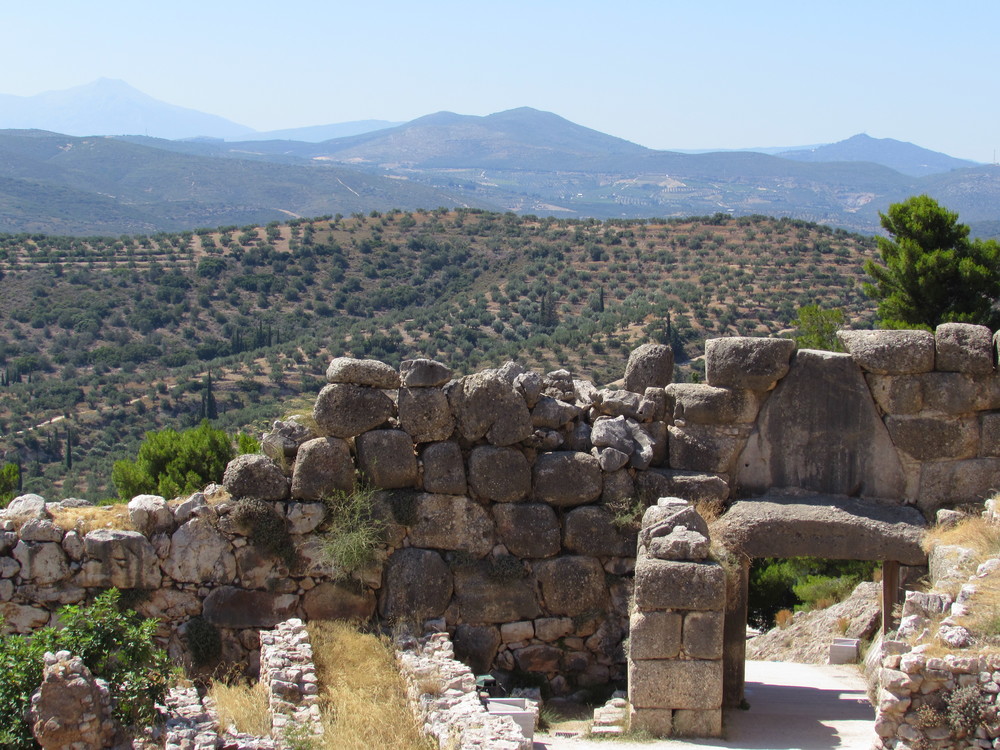
Mycenae itself was basically a fortified hill city, centred around an Acropolis. Huge, strong walls surrounded Mycenae, with stones so large, that it was said the Cyclops helped in their construction. Hence the term Cyclopean Walls.
Walking around some sections, it was hard not to make comparisons with the equally impressive stone structures built by the Inca people of Peru. Closer inspection revealed that the Mycenae stone walls were nowhere near as well laid, or sophisticated though.
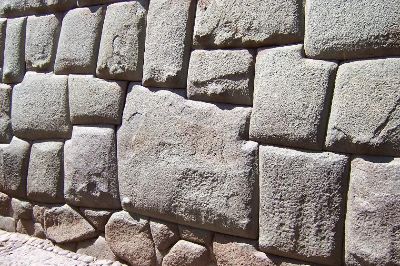
Above, you can see the wall in Peru which contains the famous '12 angled stone'. (Check out my cycling adventures in Peru , and backpacking adventures in Peru .)
Lion Gate Mycenae
Access to the fortified part of Mycenae is gained by first walking through the Lion Gate. This is perhaps the most iconic part of the entire site.
The two lions facing one another, and the Cyclopean masonry are awe-inspiring even today. I can only imagine what the ancient Greeks must have thought to this entrance gate!
The Mycenae entrance always seems to me to be part processional and part defensive. It has to be assumed that there were once wooden doors in the archway.
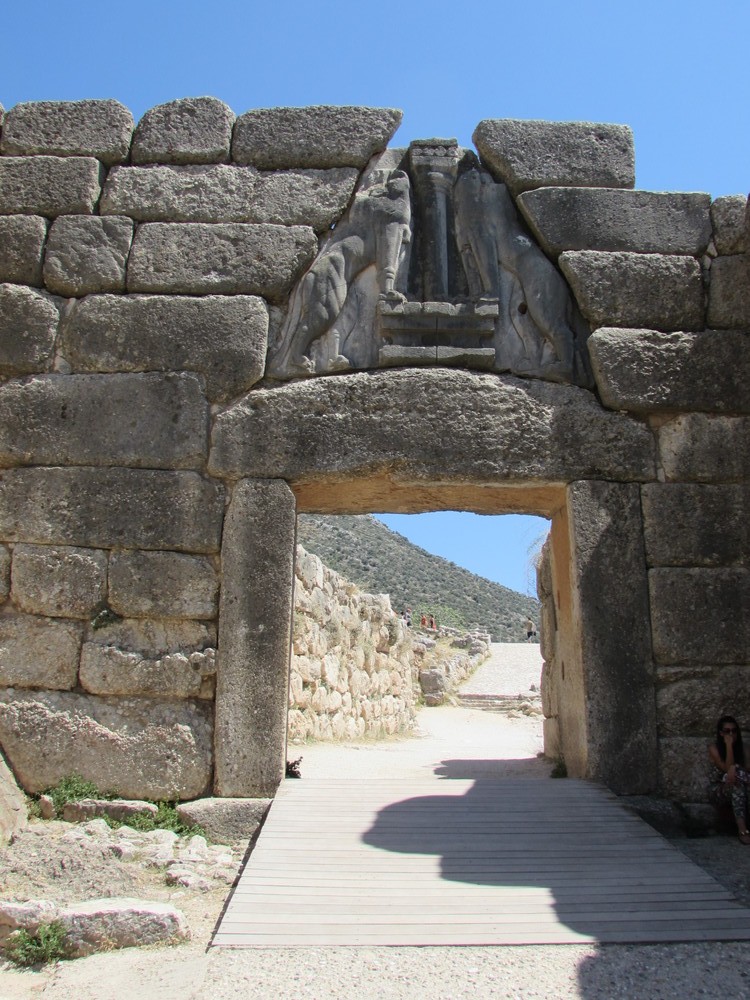
When I visited Mycenae the first time, there was also a very strong wind, and in the distance, a wildfire was burning.
I think that wildfires have been a feature of Greece since ancient times, and in fact, the city is thought to have been burnt either on purpose or by nature around 1300BC.
Cistern Passage at Mycenae
One of the more curious aspects of the ancient Mycenae site, is the cistern passage with its 99 steps. Technically, you aren't allowed inside the passage, but I guess if no one is looking….
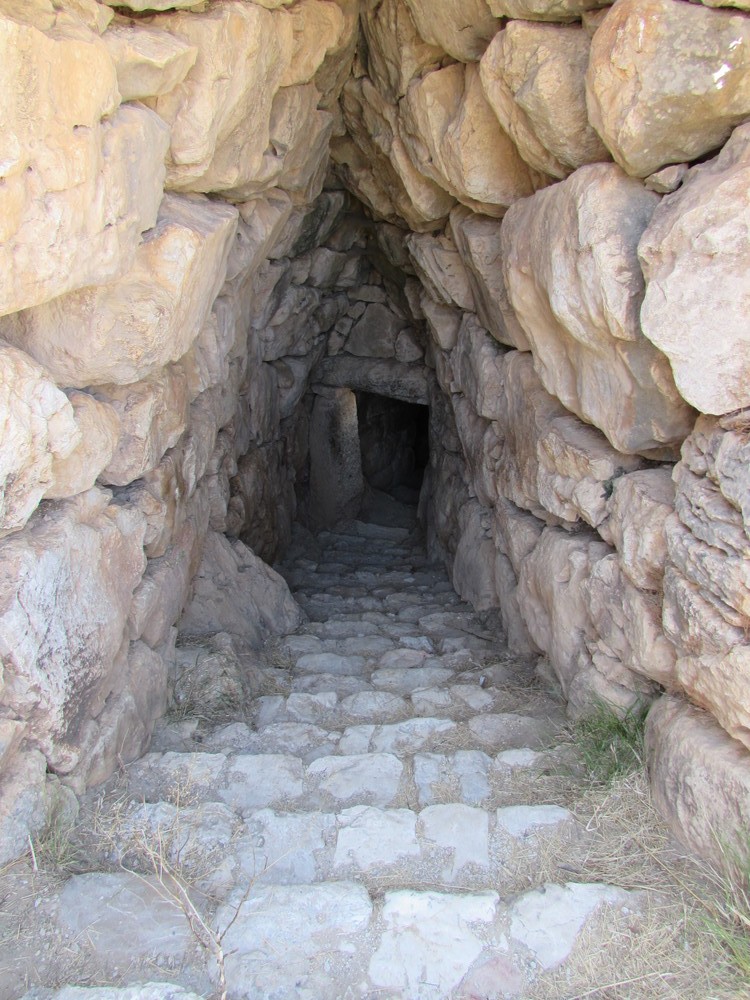
This tunnel led to an underground cistern. The cistern stored the Mycenae city water supply in times of peace and war.
Tips for Visiting Mycenae
All the usual advice for visiting ancient sites in Greece applies here. Take plenty of water, wear a hat, and slap on some sun-block.
The only bathrooms on site are located nearby to the museum, so if you want to go, use them before walking up to the top of the fort!
Interested in finding out about other UNESCO sites in Greece? Check out my guide to Greek World Heritage Sites .
FAQ for Mycenae archeological site
Here are some commonly asked questions about Mycenae in Greece:
How much does it cost to visit Mycenae?
Between April and October, Mycenae ticket prices are 12 Euro with reduced prices for various concessions such as students being 6 Euro. Price may be reduced further between November and March.
How long does it take to visit Mycenae?
Most visitors to Mycenae will find that they can see this ancient site quite comfortably within an hour and a half. This gives time to see Mycenae archaeological site itself, as well as the excellent accompanying museum.
How do I get to Mycenae?
If you are driving from Athens, take the main highway to Corinth, go over the famous Corinth Canal, and continue on until the Nafplio exit. You will shortly see the well signed Mycenae. Alternatively, simply take a day trip from Athens to Mycenae and other sites in the area.
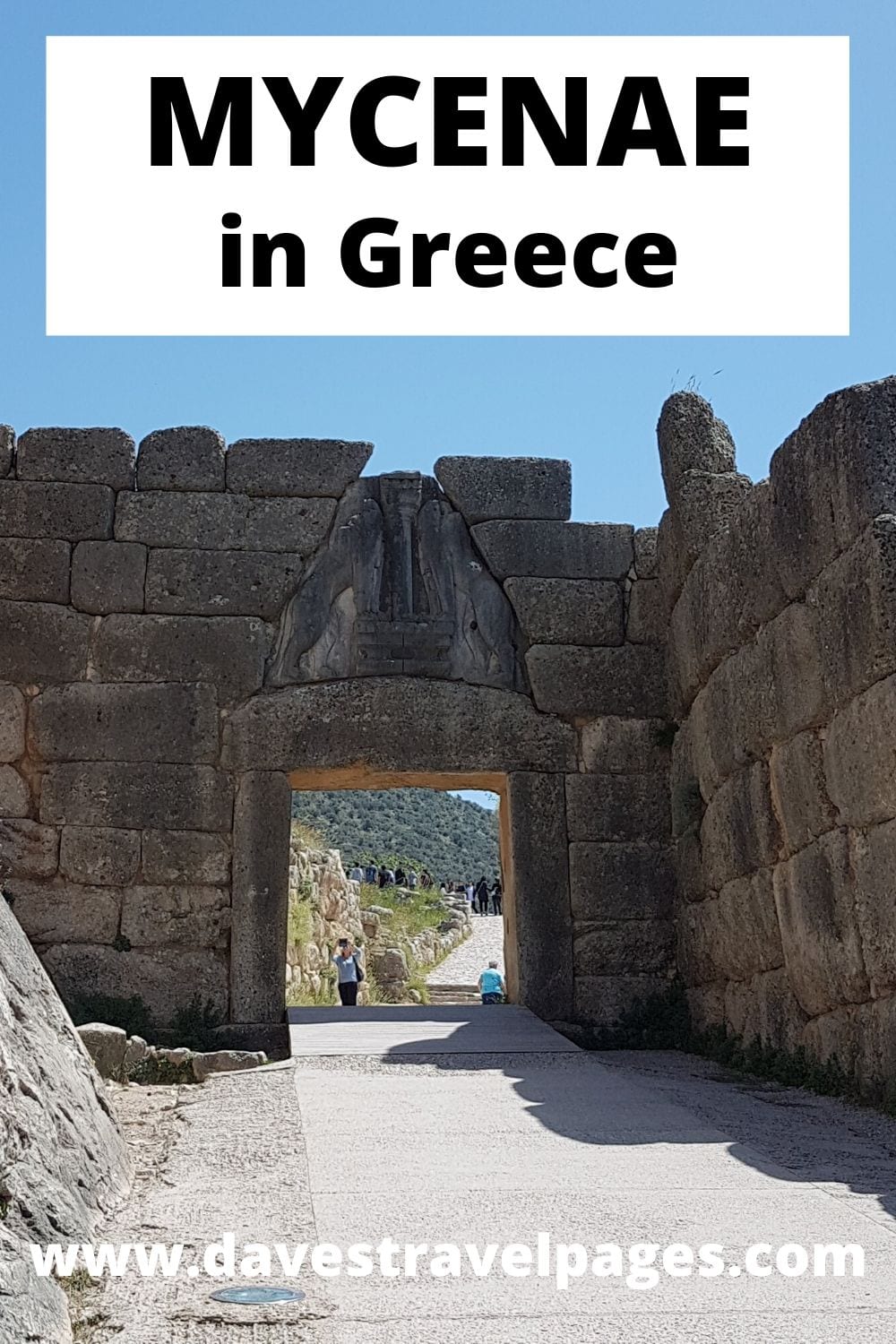
10 thoughts on “Visiting Mycenae in Greece – How to see Mycenae UNESCO Site in Greece”
Hi Dave, would you recommend paying for a tour guide to show you around Mycenae, or is it just as enjoyable to wander the sites independently? Would we be missing out on a lot if we didn’t have a tour guide?
Hi Eva, I think as long as you have done a little reading before you go (even a Lonely Plant guidebook), you don’t really need a guide. Getting to Mycenae independently is the biggest problem most people have if they don’t have a rental car.
Hi Dave, Thanks for all the information! Can you recommend a local guide for Mycenae? We will be driving there in mid June and I’d love to find an enthusiastic local guide who can explain more than us to my 8 year old. Like stories and explaining how special the things in front of her are.
I don’t know any specific guides. I do know there’s a family orientated travel website called Kids Love Greece (who I’ve worked with a few times) and they know of family friendly guides. Might be worth googling to get in touch with them.
Hi Dave. If we had to choose one site to visit with a guide, which one should we choose? Mycenae or Epidaurus?
Tough call!! Personally, it would be Mycenae because I also love the museum there
How long do you recommend to tour the site and the museum? Should I plan an entire day, or could it be accomplished reasonably in several (3-4?) hours in the morning or afternoon?
3-4 hours would be more than enough time at Mycenae!
I am an older person and have some difficulty walking on uneven surfaces. Will I have a problem when I tour Mycenae ? Thank You
Hi Paul, I don’t think so. Just take your time and it will be fine. If you use a stick, it might be beneficial to take it along with you.
Leave a Comment Cancel reply

A Guide to Visiting the Mycenae Archaeological Site
The Mycenae Lion Gate is the only Bronze Age monument still surviving in Greece and it stands at the entrance to the greatest citadel of the Ancient Mycenaens. Here’s everything you need to know abou t how and why to visit, what to see, and where to stay. See the Grave Circles, the Treasury of Atreus (the Tomb of Agamemnon), and the spectacular Lion Gate, only 120 kilometers from Athens and a stone’s throw from lovely Nafplio.
How to Avoid the Crowds at the Mycenae Archaeological Site
There is a well-worn path that tour buses take from Athens for day trips into the Peloponnese. After stopping at the Corinth Canal and Ancient Corinth, the convoys roll on to Mycenae.
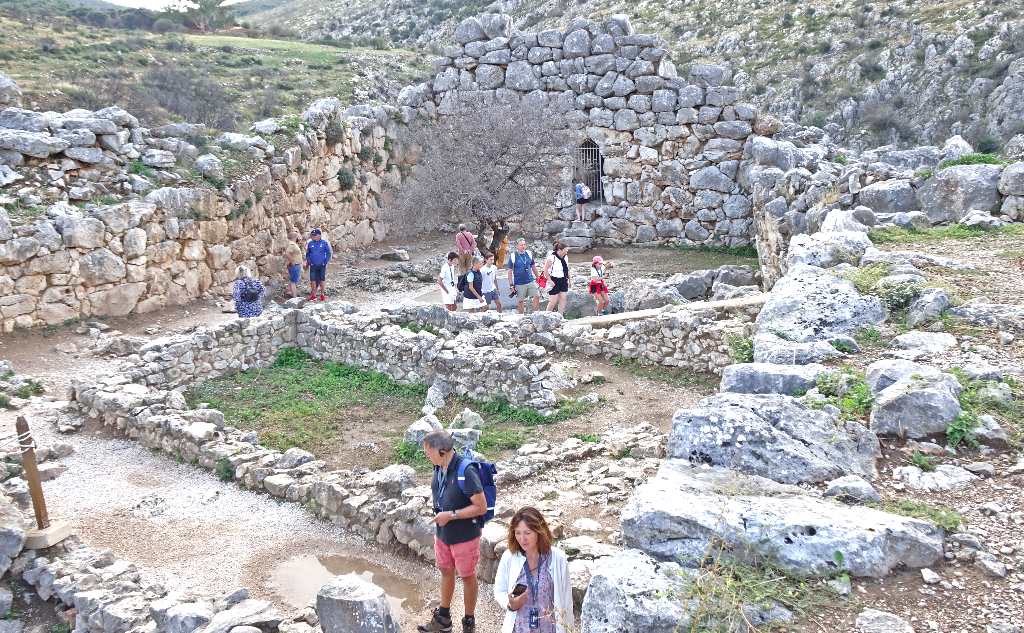
My advice is to stay in Nafplio and get to the site as it opens. Leave the Museum to last and head straight into the complex.
On your way back down from the site, visit the Museum and the tholos and area closest to the entrance.
The tour buses don’t give the tourists enough time to walk down to these tombs and you’ll see them looking down at you as you (often) have the whole place to yourself.
Once you’ve finished these sections, head out of the gate to the Treasury of Atreus.
How to Get to Ancient Mycenae
The archaeological site of ancient Mycenae is located in the northeast of the Peloponnese Peninsula in southern Greece, between the cities of Argos and Corinth.
Mycenae is only 120 km from Athens, less than an hour and a half to drive across the Isthmus of Corinth (the neck of land that joins the Peloponnese to mainland Greece).

You can also get to Mycenae via coach or even train, though this can take a little longer and you might need a taxi on the journey’s final stretch.
Mycenae is very close to the incredible coastal town of Nafplio, a whole archaeological destination in its own right! Here you can have wonderful sea views, only a 20-minute drive from Mycenae.
This article may contain compensated links. Please read the disclaimer for more info.
Archaeological Site of Mycenae: E-Ticket With Audio Tour
I’ve used this provider – Clio Muse Tours a lot – you can get hold of them by phone at any time! Don’t make the mistake of queueing for a ticket with busloads of people.
From Athens: Bus Trip to Mycenae, Epidaurus & Nafplio
The most popular bus trip day tour from Athens, booked dozens of times a day throughout the year. It includes 2 hours for you to explore Mycenae.
Athens: Peloponnese Highlights Day Trip and V.R. Audio Guide
Stop at Corinth Canal, Mycenae, Nafplio, and Epidaurus. You get a V.R. audio guide and 2.5 hours to discover Mycenae.
From Athens: Mycenae and Epidaurus Full-Day Tour
Also super-popular, I like that this day trip includes an 80-minute guided tour of Mycenae.
The Myceneans and Mycenean Civilization
Mycenae is not just an archaeological site: it has also given its name to one of Greece’s most important civilizations.

Mycenean society was hierarchical and patriarchal, dominated by a warrior elite, and organized in a network of city-states based around hilltop palaces.
Supplanting their predecessors, the pre-Greek Minoans of Crete, around 1600BCE (BC), the Mycenean kings dominated modern-day Greece for around five hundred years, making key advancements and innovations before falling into decline during the Bronze Age collapse of 1100BCE (BC).
When the Ancient Greeks wanted to create myths and legends, they drew upon their ‘Ancients’ – the Myceneans. The eventual collapse of the wealthy Mycenean culture ushered in the Greek Dark Age.

Got Questions? Join our friendly Greece Travel Planning, Tips + Deals
Mycenean Culture
The Myceneans left such a great stamp on this period, that the last stage of the Hellenic Bronze Age is now known today as the Mycenean Age .
Many of Greek mythology’s most enduring stories, including Homer’s Iliad, have their roots in this time.
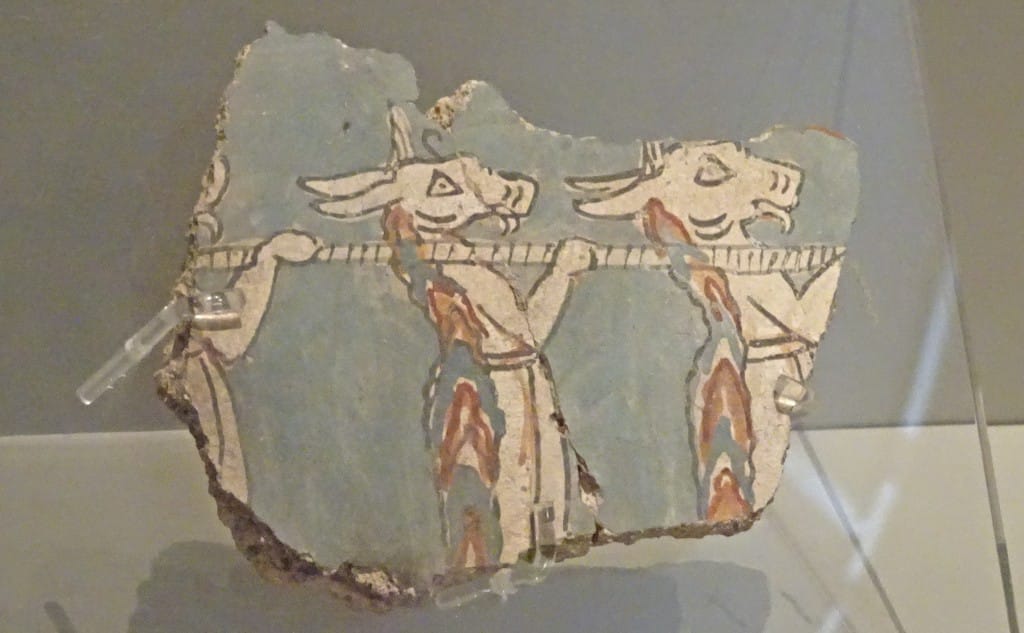
It was the Mycenaeans who developed (with help from the Minoans) the first Indo-European writing system, Linear B .
Mycenae was firmly integrated into the Mediterranean’s Bronze Age world and was in frequent contact with great powers such as Ancient Egypt and the Hittite Empire.
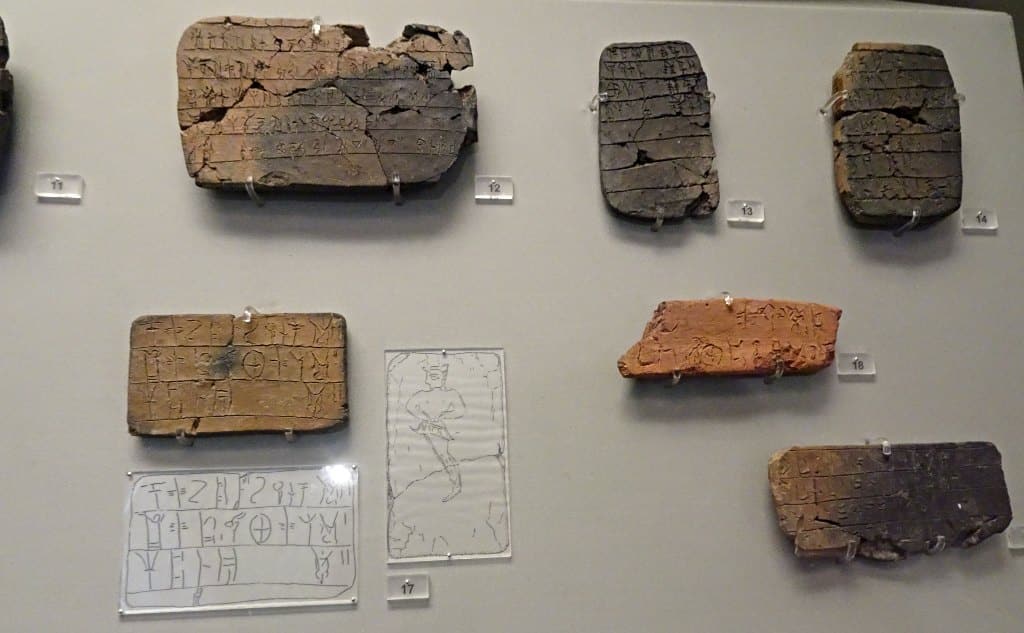
Mycenean goods, particularly their ornate bronze metalwork, have been found as far away as Georgia on the Black Sea and Cornwall in England, while their pottery was prized across the region for its colorful and stylish design.
Mycenaen Art, especially pots, urns, and other ceramics frequently depicted the warrior culture that was so much a part of everyday life.
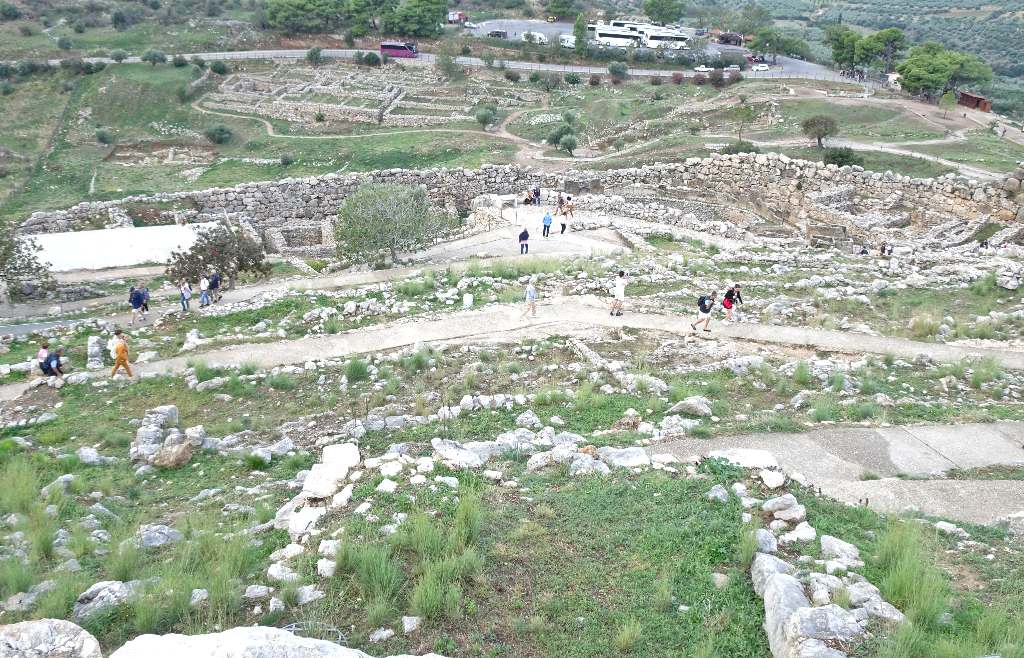
The Myceneans were great empire builders, warriors, and mercenaries, and created so much wealth that the society could afford for the arts to flourish.
Today, however, the Mycenaeans are best known for their impressive, fortified palaces, of which the Archaeological Site of Mycenae is the greatest example.
The Mycenae Archaeological Site
The area around Mycenae has been occupied since at least 5000 BCE (BC), but it is thought that the construction of the great citadel we can see today only began around 1350BCE (BC).
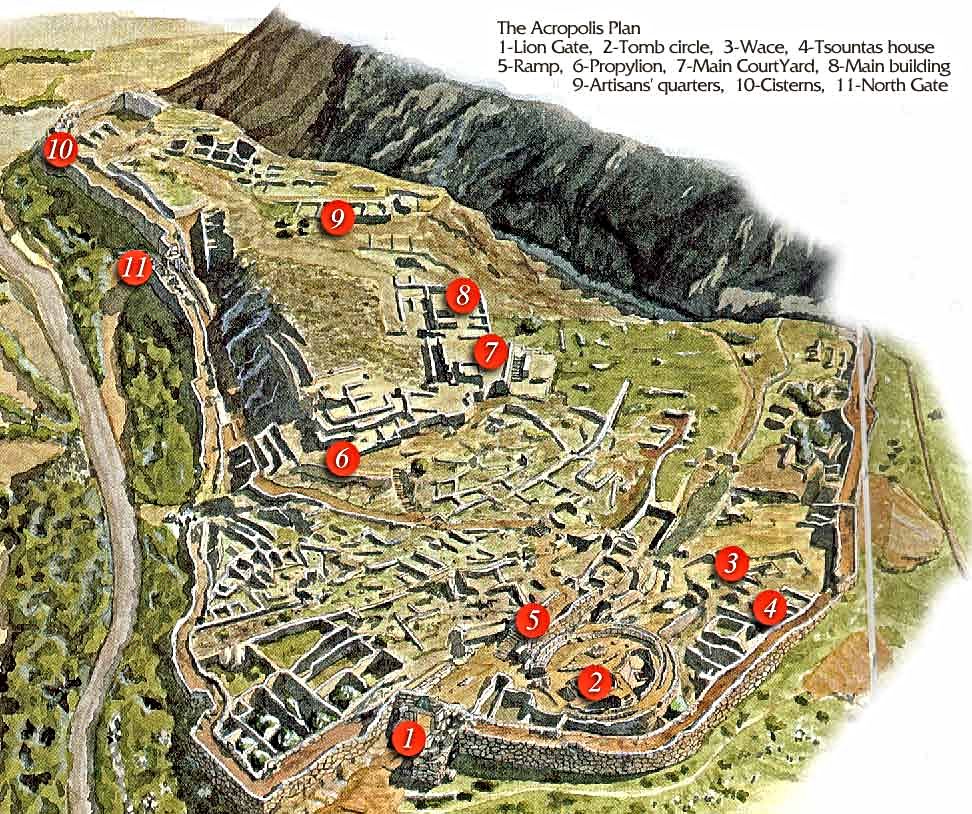
The rise of the city of Mycenae mirrored the rise of Mycenean power, and at its peak, the site had grown to become the focal point of the Hellenic world.
But Mycenae’s power could not last forever. In around 1200BCE (BC) the city was sacked during the Bronze Age collapse by invading Dorians, migrating Sea Peoples’, or perhaps the city’s own exploited laboring classes.
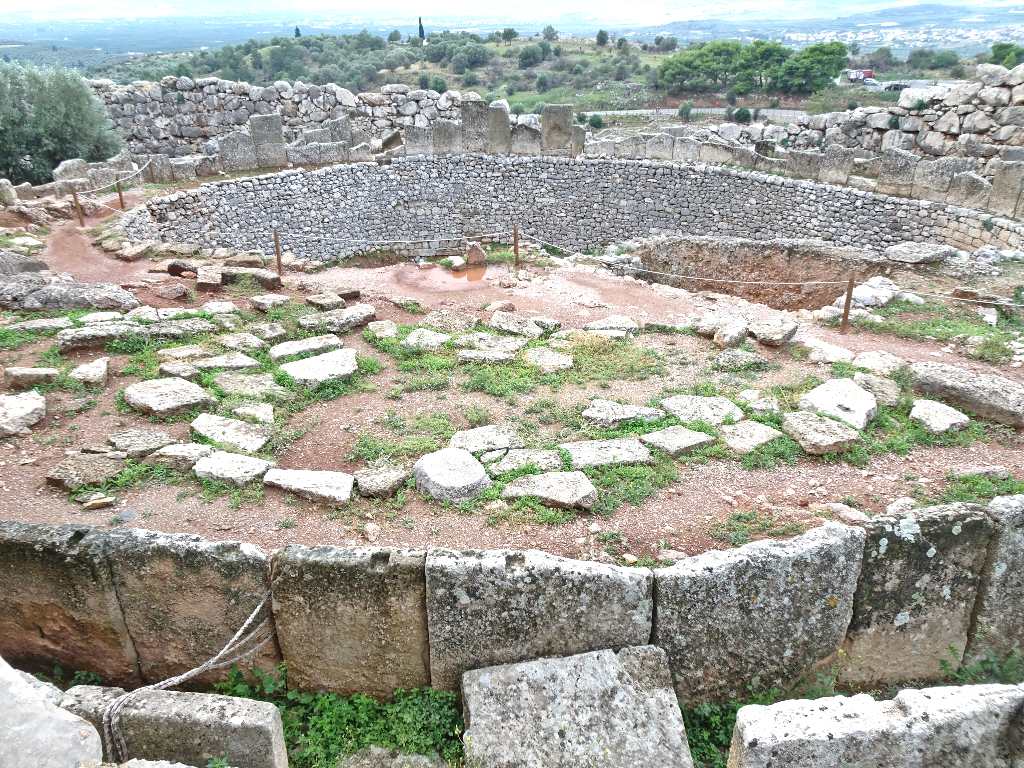
Mycenae’s ruins had become little more than a tourist attraction by the Roman period and fell into total obscurity during the Dark Ages.
The site was only rediscovered in 1700 by the Venetians, who identified it via Roman descriptions of its iconic Lion Gate .
Excavations have been ongoing at Mycenae since 1841 at which point the Lion Gate was reconstructed, with key work on the site later undertaken by the rediscoverer of Tro y , Heinrich Schliemann.
Citadel of Mycenae
At the center of the archaeological site is its imposing citadel. In around 1350 BCE the previously humble settlement at Mycenae was fortified with “Cyclopean walls “, later thought to have been built by the enormous Cyclops of Greek legend.

Like nearby Tiryns , Cyclopean walls were used to construct wide and tall fortifications. The stones used in these walls are so large that it was thought only the mighty Cyclops could have moved them into place.

Unlike their Minoan predecessors, Mycenean settlements are known for their focus on the military , and Mycenae was first and foremost to be a strong point, commanding this strategic area around the entrance to the Peloponnese.
That said, the citadel was hardly Spartan. A succession of lavish palaces, tombs of kings, and sacred monuments were built within Mycenae’s walls over the ensuing centuries.
After all, the city of Mycenae was an acropolis, a fortified upper town that was home only to the elite and a testament to their power. Commoners lived outside the protection of the walls on the slopes below the hill.
The Lions Gate at Mycenae
The impressive Lion Gate marks the main entrance of the Bronze Age Citadel of Mycenae. It has stood guard since its construction in the 13 th Century BC (BCE).
It is the only monument of Bronze Age Greece to survive intact, with its iconographic motif still visible today.

Situated at the northwest side of the Acropolis, this monumental piece of Mycenaean sculpture is the largest sculpture in the prehistoric Aegean, standing three meters wide and three meters high at the threshold.
The Lion Gate gets its name from the relief sculpture carved into the relieving triangle above the gate’s lintel.
On this great slab, two lions or lionesses sit facing a central pillar atop an altar. Unfortunately, the heads of the lion statues have been removed.
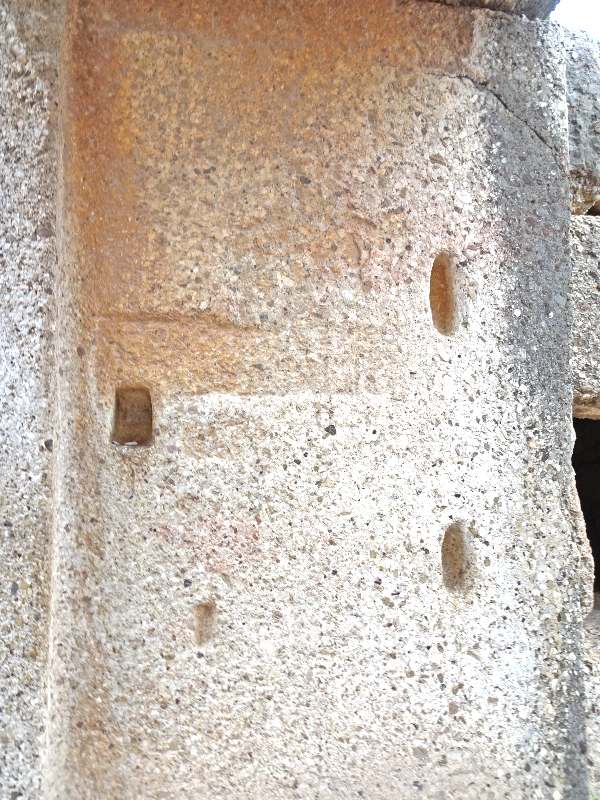
The relief has stimulated much debate among archaeologists, who still debate the sex of the lions (or lionesses) or whether they were indeed sphinxes.
The presence of the altar and the single column in between the lions may allude to a ceremonial gateway known as a Propylaea, with the lions themselves acting as Mycenae’s sanctified guardians.
The Graves of Mycenae
Prominent at Mycenae is a series of graves that are open to the public. Most famous are the grave circles, a series of mostly shaft graves buried deep into the ground.
This grave design was later abandoned in favor of the tholos design, best embodied in the Treasury of Atreus .
Grave Circle A
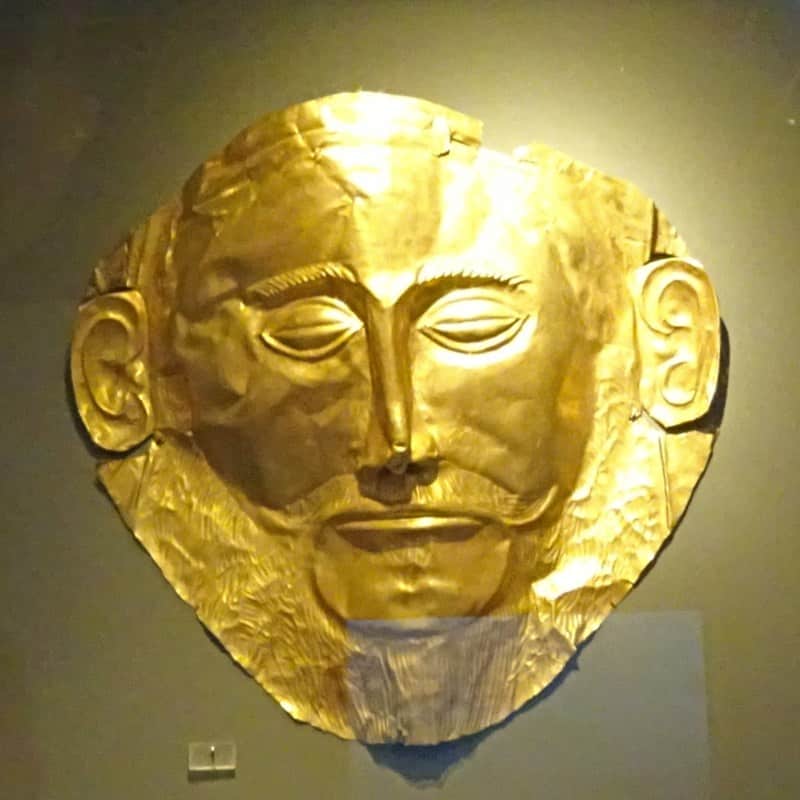
The first circle of graves was discovered by Heinrich Schliemann, and although probably a continuation of Grave Circle B, it is now known as Grave Circle A.
Dating back to 1600BCE (BC), Grave Circle A contains six shaft graves in which rested the bodies of nineteen royals.
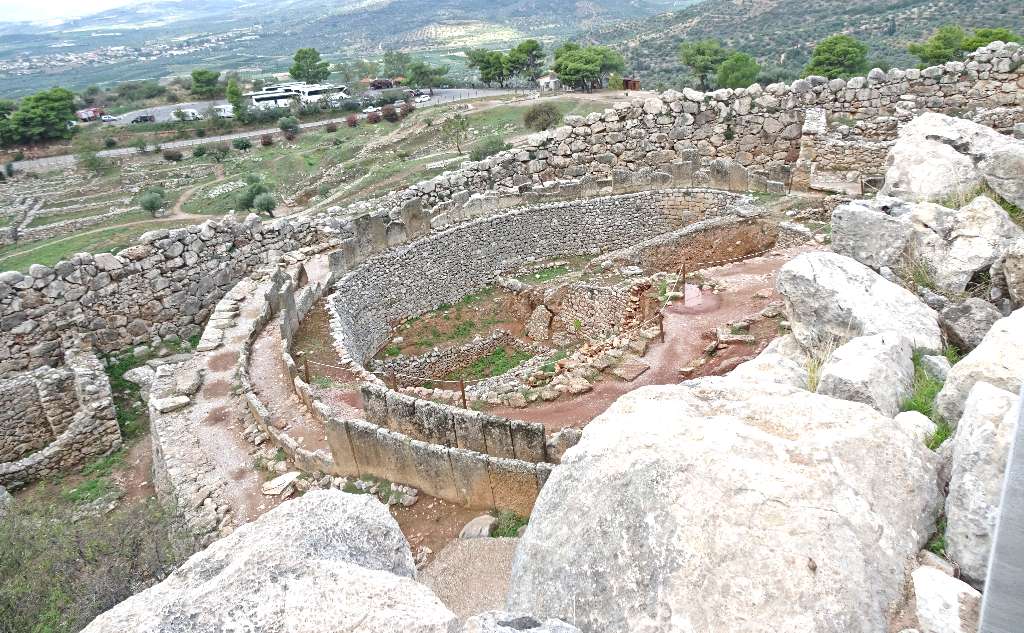
It was here that Schliemann found his famous “Mask of Agamemnon” , a golden face mask over the body of a man that the German archaeologist connected to the mythic hero of the Trojan War.
Grave Circle B
Built up to a century before Grave Circle A, Grave Circle B is situated outside the acropolis walls of Mycenae. You’ll see it after you pass the entrance to the site, on your right.
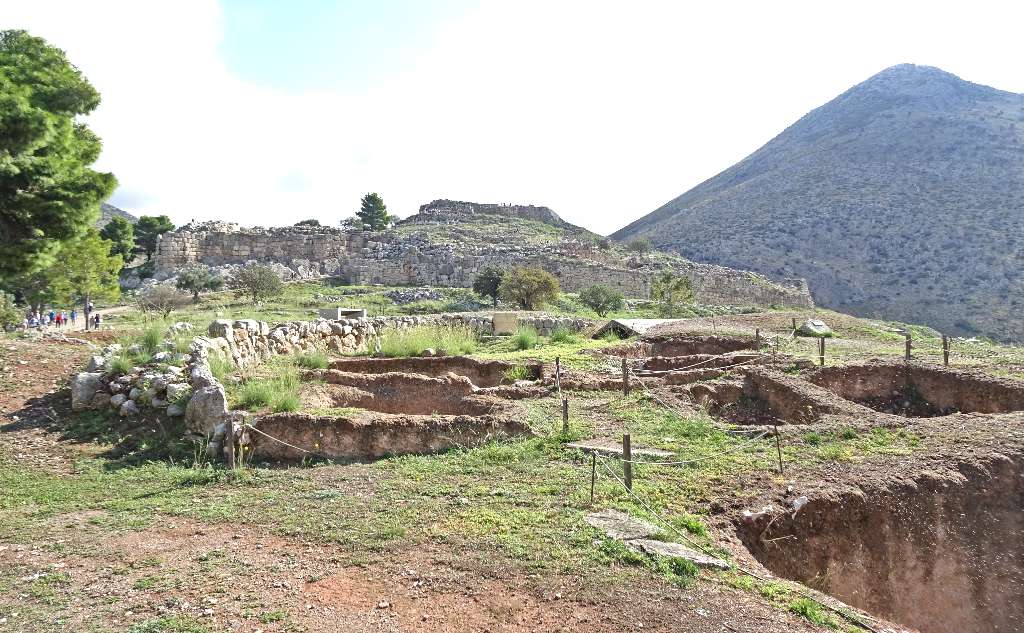
This Grave Cicle comprises twenty-six shaft and more primitive cist graves and contained twenty-four aristocratic bodies.
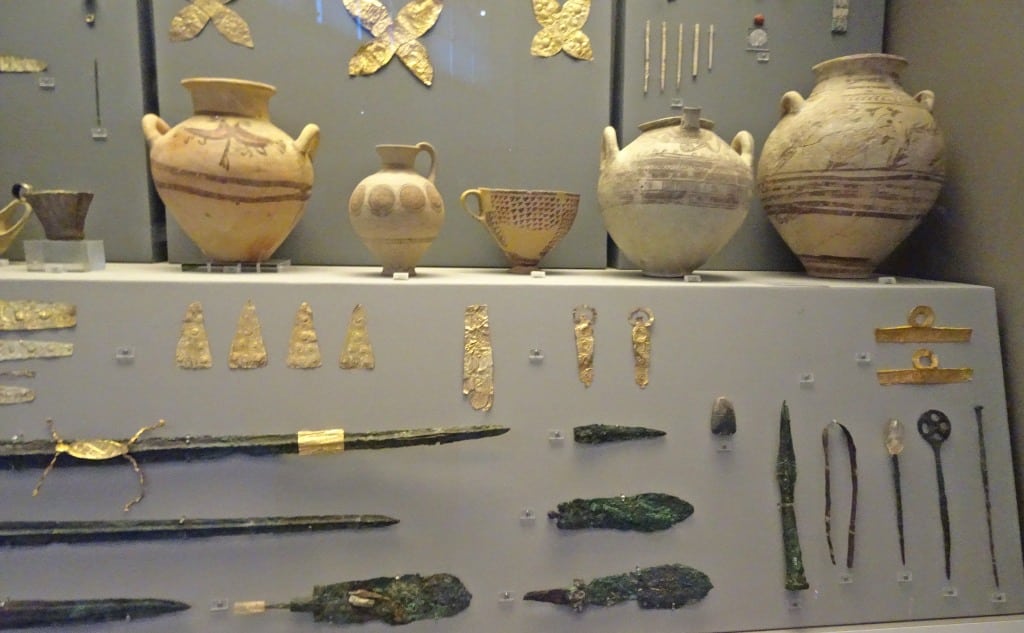
Archaeologists have used Grave Circle B to trace the changes in Mycenean society, noting that later graves contained richer and more diverse goods, with women seeming to be buried with higher status.
Museum of Mycenae
The Museum is on your left as you walk the main path to the Lion Gate entrance to the citadel.
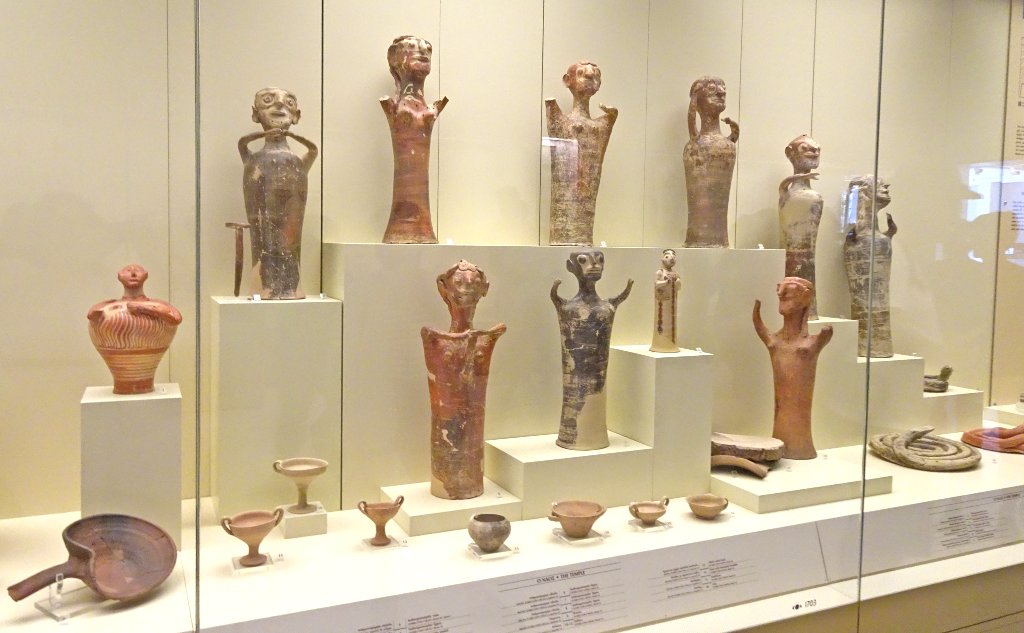
The best parts of the Mycenaen hoard are found in the National Archaeological Museum in Athens, but there are some lovely female figurines in the museum that are worth seeing.
Treasury of Atreus (the Tomb of Agamemnon)
After you leave the main Mycenae archaeological site, you’ll see the tour buses lined up a little way down the main road – this is where you’ll find the Treasury of Atreus.
Also known as the Tomb of Agamemnon , the Treasury of Atreus was built around 1250 BCE (BC), well after the older Grave Circles and at the height of Mycenean power.
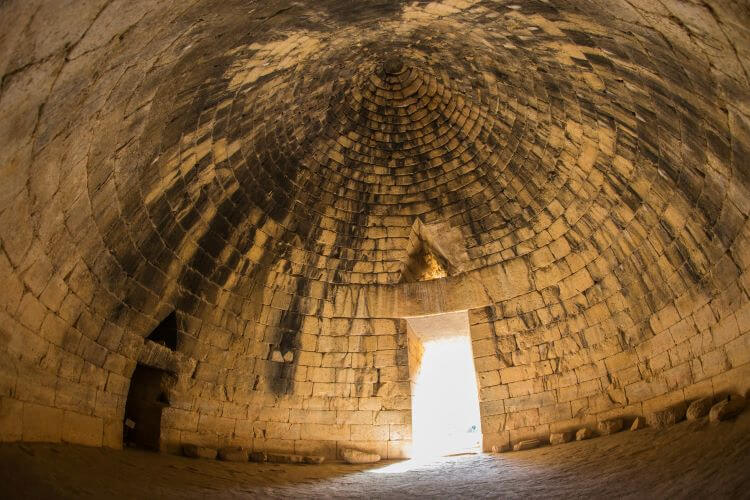
The Treasury of Atreus is a tholos or beehive tomb, a design that became popular in the late Mycenean period.
With its long sloping entrance and huge domed interior, the Treasury of Atreus is magnificent to behold millennia later.
And although just one of nine of its kind at Mycenae, the grandeur of this structure dwarfs all the others. So don’t miss it!

Best 13 Santorini Hotels with Cave Pools + River Cave Pools

Visit Chora, Amorgos Island
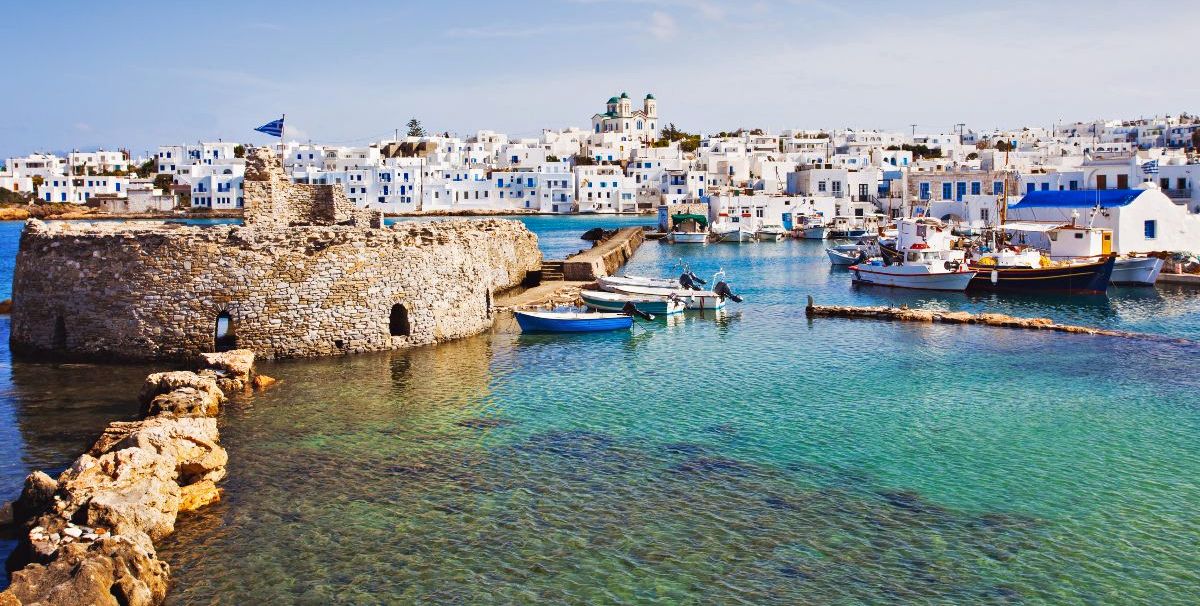
17 Things to Do in Naoussa Paros, Greece

Hi! I'm an anthropologist & history travel expert. I spend a part of each year in Greece, Italy, & Cyprus.
You can plan & book your next trip here while learning more about the cultures & histories of some of the world's most exciting destinations.
Visiting Mycenae: An ancient empire
The Greek archaeological site at Mycenae was once the centre of power for the Mycenaeans.
Written by Michael Turtle
Michael Turtle is the founder of Time Travel Turtle. A journalist for more than 20 years, he's been travelling the world since 2011.
Michael Turtle is the founder of Time Travel Turtle and has been travelling full time for a decade.
Updated: December 14, 2023
Visit Mycenae
Before the Ancient Greeks consolidated their power around Athens, another great empire - the Mycenaeans - ruled the region from their base at Mycenae, which is now one of the most important archaeological sites in the country.
To give you a bit of background and help you plan for a visit to Mycenae, I've put together this information, including:
- The story of the Mycenaean Empire
Things to see at Mycenae
What about tiryns.
- My top tips for visiting Mycenae
While it’s the Acropolis in Athens which gets all the attention when people think of Ancient Greece, another site, about 120 kilometres away on the Peloponnese, has a much more romantic history.
(Yes, I said ‘romantic’ – you’ll see why!)
On the site known as Mycenae, the Mycenaean culture built their citadel about a thousand years before the Acropolis existed!
For about four hundred years between the 16th and 12th century BC, their civilisation spread to all known areas in the Mediterranean basin. It was one of the most powerful empires of the time. And all of it was controlled from this hill.
Mycenae was the royal house, the centre of communication routes, and the most fiercely defended community of the Mycenaeans.
But, as far as legend is concerned, the ancient city of Mycenae is best known as the heart of the empire which launched the famous attack and siege on Troy that led to the Trojan War, one of the most famous stories of the Classical World.
Ancient poets such as Homer told stories of the Mycenaean era and its role in the tale of a face that launched a thousand ships.
In short, when Helen (Queen of Sparta) eloped to Troy with her lover Paris, her husband was so enraged he called on the kings of Greece to wage war. It was Agamemnon, the King of Mycenae, who led the armada to bring her back.
Long thought to just be a legend, after the archaeological discovery of Troy in the 19th century, many historians now believe that perhaps Agamemnon was a real person. And, if so, it would’ve been here at Mycenae that he lived.
And this is why I think Mycenae has a romantic story… even if it’s also pretty violent. (Spoiler alert: The Trojan War doesn’t really end well for anyone).
The best way to visit Mycenae from Athens is on a tour, and I would recommend this great day trip , which also includes Epidaurus and Nafplio.
But more than three thousand years have passed since those days and the citadel on the mountaintop lies in ruin today. There’s still lots to see – including impressive tombs and some intricate artwork, but you’ll need to use your imagination a bit.
Still, it’s easy to see why Mycenae (along with the nearby site of Tiryns) was added as one of the Greek World Heritage Sites .
What is Mycenae?
Mycenae was an important city at the centre of the Mycenaean Empire for hundreds of years from about 1600 BC and was home to about 30,000 people at its peak in the 14th century BC.
Why is Mycenae significant?
Mycenae was listed as a World Heritage Site because of its important role in the development of classical Greek culture as the base for the Mycenaean Empire – and because of its role in the Homeric epics of the Iliad and the Odyssey .
Is it worth visiting Mycenae?
There are lots of things to see at Mycenae and it’s certainly worth visiting to get a sense of the opulence of this ancient kingdom, with some well-preserved artefacts. It makes for an easy day trip from Athens or nearby Nafplio.
Visiting Mycenae today, there’s lots to explore and you’ll easily spend more than an hour here. It makes for one of the most interesting day trips from Athens , especially when combined with sites like Epidaurus .
There are ingenious inventions to control water and light at the site that were ahead of their times; structures of buildings would influence civilisations to come; and decorative features that still exist in parts of the ruins have been proven to be the first of their type in the world.
The Mycenaean Empire
To get a sense of how old the Mycenaean Empire is, it’s perhaps best to compare its timeline with that of Ancient Egypt. The Pyramids at Giza were well and truly built by the time the Mycenaeans came along. However, their period of influence is almost exactly the same as when the pharaohs were being laid to rest in the Valley of the Kings .
In other words, a very long time ago – about 3500 years ago, to be exact.
The Mycenaeans were primarily based on the mainland, around the Peloponnese, from around 1750 to 1050 BC. They were influenced by the earlier Minoan civilisation, which had spread from its origins at Crete to include the wider Aegean.
The Mycenaeans adopted many aspects of Minoan culture, such as architecture, art, religion, and writing – and they worshipped many of the same gods that later Greeks did, such as Zeus, Hera, Athena, and Apollo.
A warlike people, the Mycenaean Empire expanded its influence throughout Greece and across the Aegean Sea. They traded with other Bronze Age cultures in Cyprus, Anatolia, Egypt, and the Levant. They also fought with them, especially with the Hittites over control of Troy, as I’ve already mentioned.
With fighting, comes the need for defence, and the Mycenaeans were known for their fortified cities – Mycenae being the most famous, but other important ones were Tiryns, Pylos, and Thebes.
These cities were built around large palace complexes that served as administrative and economic centers. The palaces were richly decorated with frescoes, sculptures, and gold objects, but they also stored goods like wheat, oil, wine, and wool.
The Mycenaean civilization collapsed around 1050 BC, along with other Bronze Age cultures in the eastern Mediterranean. The reasons for this collapse are still debated by historians, but they may include natural disasters, invasions, internal conflicts, or social and economic decline.
But the Mycenaeans were not forgotten and they left behind a rich legacy that influenced later Greek culture and history. Their achievements in engineering, architecture, and military organisation set standards for future civilisations.
And, of course, their myths and legends inspired generations of poets, artists, and philosophers. These works are still some of the most famous today, more than 3000 years later.
When you visit Mycenae, the best thing to do is follow the path that will lead you to all the main attractions, sometimes deviating to some of the less important ruins, and then coming back to the main trail.
But before you head up into the citadel, I recommend taking the short walk along ground level to the Treasury of Atreus , also called the Tomb of Agamemnon. It’s the largest and most elaborate tomb of this style known to have been constructed during the Bronze Age.
Although it’s not known who was buried here, the tomb was named in the 18th century for the legendary Mycenaean king Agamemnon, even though there’s no evidence it was his grave (or that he even definitely existed!). Still, it was clearly meant for someone very important, and this is one of the most significant things to see at Mycenae.
On that way back to the citadel entrance, you can also see two more vaulted tombs that are at ground level near the entrance. The Tomb of Aegisthus and the Tomb of Clytemnestra , in particular, are amazing funerary monuments that were built in the 13th century BC.
Shaped like a beehive, the facades would’ve been decorated with two columns. Inside, the brick ceiling and walls seem to stay in place miraculously and make it feel like perhaps you could be entombed here.
Heading up the hill, the first thing you’ll come to is the Lion Gate , one of the most important things to see at Mycenae.
It got its name because of the carving of two lionesses in a heraldic pose above the gate. Other than its artistic value, the Lion Gate is also important because it’s the only surviving piece of Mycenaean sculpture.
Through the gate, you’ll first reach the Royal Graves , more technically called Grave Circle A. This is one of the earliest parts of the citadel, first used in the 16th century BC as a cemetery when it would’ve been outside the city walls.
The circle itself is almost 30 metres across and there are six shafts going down to graves, with up to five people buried in each shaft. Within these graves, archaeologists found some of the most valuable treasures of Mycenae, including gold death masks.
Walking further along the path, you’ll pass through ruins that show the foundations of houses and other buildings that make up the bulk of the city. Towards the top, you’ll reach the Palace of Mycenae , the centre of this ancient city.
Although in ruins now, you can make out the layout of the palace (which would’ve changed a few times over the centuries). There’s the main courtyard, the throne room, a grand staircase and also a temple.
Continuing on, there are more houses on the other side of the hill. Make sure you keep going because you’ll soon reach the cistern and the striking tunnel that leads to it through the rock.
After you’ve seen all the highlights of the archaeological site, it’s time for the Museum of Mycenae , which is back near the entrance. The museum has a great collection of artefacts found during the archaeological digs of the ruins, which give you a much better idea of what life was like for the Mycenaeans.
The museum also does a good job of telling the tale of the Battle of Troy and the subsequent Homeric poems, in which the empire played such an important role.
Exactly what in those stories is true is still debated to this day. There is no question, though, about the importance of the Mycenaean empire and the evidence of it that remains.
I can’t really talk about Mycenae without also mentioning Tiryns, another of the ancient Mycenaean cities.
That’s because Tiryns has been combined with Mycenae to create one of the World Heritage Sites in Greece – and it’s only about 20 kilometres away, very close to the city of Nafplio.
Although Tiryns only had about half the population of Mycenae, it was still one of the most important cities of the kingdom, acting as a powerful centre for centuries between about 1400 BC and 1200 BC.
Tiryns once had a huge palace, the ruins of which are the main feature at the archaeological site today. There were various rooms built around a central courtyard, including an adjoining temple.
The tunnels throughout the citadel also show an impressive level of engineering, built of massive limestone boulders. But the wall around Tiryns is also a feat, with the base still surviving around its whole length, reaching up to seven metres high at some points.
Out of these two sites, most people choose to visit Mycenae, which makes sense because it’s much larger and has a greater variety of landmarks to discover. If you only have time for one, I would recommend Mycenae.
But, if you’re in the area and interested in getting a better understanding of the Mycenaean Empire, it’s easy to do both if you have a car (they’re only about 20 minutes drive apart) and they’re different enough to make it worthwhile.
Tiryns is open from 08:30 – 15:30. It is closed on 1 January, 25 March, Easter Sunday, 1 May, 25/26 December
Entry to Tiryns costs €4 from April – October and €2 from November – March.
Visiting Mycenae
There are quite a few important archaeological sites in the Peloponnese region but visiting Mycenae is one of the highlights because of how different it is (so many of the others are related to the era of the Athenians).
Having said that, if you’re doing a day trip from Athens to Mycenae, I think it’s worth including Epidaurus and its theatre , Corinth, and possibly Tiryns too (if you want even more Mycenaean!)
Because Mycenae is set on a hill, there’s a bit of walking involved to see the ancient city, but the paths are pretty good so I wouldn’t say it’s a particularly difficult place to explore.
Although the archaeological site of Mycenae is mainly in ruins, there are still quite a few things to see across the site. Although it’s not too spread out, I would recommend giving yourself about 60 – 90 minutes to visit Mycenae, including seeing the museum on-site.
There are a few lovely tavernas in the small town on the way to the main entrance where you can get a good meal, but the site itself can be very hot and sunny, so I recommend taking some water and perhaps a few snacks.
Where is Mycenae?
Mycenae is on the eastern edge of the Peloponnese, just north of Nafplio and about 120 kilometres drive from Athens. You can see it on a map here .
How do you get to Mycenae?
To get from Athens to Mycenae by public transport, there are regular buses from Kifissos station towards Nafplio that stop at Fichti (about 4 kilometres from the site), from where you can walk or take a taxi. Check the timetable here . If you’re coming from Nafplio, there is this one direct bus to and from Mycenae each day (leaving Nafplio at 09:30 and returning from Mycenae at 12:00). However, the easiest way to get to Mycenae from Athens is by car, and the drive will take about two hours. (If you need to rent a car, I recommend using Discover Cars in Greece.) Or you may find it’s worth joining a tour from Athens to avoid the logistical hassle.
When is Mycenae open?
Mycenae is open at the following times during the year: April: 08:00 – 19:00 May – August: 08:00 – 20:00 1 September – 15 September: 08:00 – 19:30 16 September – 30 September: 08:00 – 19:00 1 October – 15 October: 08:00 – 18:30 16 October – 31 October: 08:00 – 18:00 November – March: 08:30 – 15:30 Mycenae is closed on 1 January, 25 March, 1 May, Easter Sunday, 25/26 December
How much does it cost to visit Mycenae?
Admission to Mycenae is €12 for an adult and €6 for a concession. From November to March, entry costs just €6. You can buy a combined ticket for €20 that also includes Tiryns, Asini, Palamidi, Museum of Nafplio, and Byzantine Museum of Argos
Are there tours to Mycenae?
Yes, there are a few good tours to Mycenae from Athens that usually include other nearby sites and are a convenient way to visit the site. I would recommend this affordable tour that also goes to Epidaurus and Nafplio, or there’s this comfortable private tour for up to four people. You can see more options here .
Although I personally like to travel independently, this is a case where I would recommend a tour to visit Mycenae if you don’t have a car.
Firstly, the public transport connections are a little tricky and you’ll end up spending a lot of time just travelling if you do it on your own (for starters, the bus leaves from Kifissos station in Athens, and then it drops you about 4 kilometres from the entrance!).
But more importantly, there are lots of really interesting things to see in the area that will be impossible in one day by public transport. A tour, on the other hand, will be able to take you to several of them.
Also, some of the tours to Mycenae and surrounds are quite affordable and are basically just like a convenient tourist bus (with the bonus of having a guide).
For a fantastic day trip that includes Mycenae, Epidaurus, and Nafplio, I would recommend this affordable group tour , or there’s this comfortable private tour for up to four people.
For some other options with different sites, there are these good ones:
So much of the heritage in Greece is related to one period, and while it’s a fascinating era, it’s nice to see something a bit different, which is why I would always recommend a visit to Mycenae to people who are staying in Athens.
Of course, there are lots of things to see in Athens itself, but getting out of the city for a day to explore these archaeological sites is certainly worth it.
This site is on the UNESCO World Heritage List ! I'm on a mission to visit as many World Heritage Sites as I can. Only about 800 more to go... eek!
More stories about Greece
- A 3 day itinerary for Athens
- The best way to visit the Acropolis
- How to do a Delphi day trip from Athens
- What to do on Hydra
- The best day trips from Athens
- Seeing where the Olympics started
- Why the Epidaurus theatre is so important
- Visiting the ancient city of Mycenae
- The ancient luxury island of Delos
- All the World Heritage Sites in Greece
Leave a comment Cancel reply
In greece, i recommend:.
🏨 Hotels: Booking.com 👩🏫 Tours: GetYourGuide 🚗 Car hire: Discover Cars ⛴️ Ferries: Ferryhopper
Find me on the socials:
Subscribe for news and deals:.
top stories:
Take advantage of the search to browse through the World Heritage Centre information.
Share on social media
Unesco social media, archaeological sites of mycenae and tiryns.
- Description
The archaeological sites of Mycenae and Tiryns are the imposing ruins of the two greatest cities of the Mycenaean civilization, which dominated the eastern Mediterranean world from the 15th to the 12th century B.C. and played a vital role in the development of classical Greek culture. These two cities are indissolubly linked to the Homeric epics, the Iliad and the Odyssey , which have influenced European art and literature for more than three millennia.
Description is available under license CC-BY-SA IGO 3.0
Sites archéologiques de Mycènes et de Tirynthe
À Mycènes et à Tirynthe subsistent les ruines imposantes des deux plus grandes cités de la civilisation mycénienne, qui domina le monde de la Méditerranée orientale du XV e au XII e siècle avant J.-C. et qui joua un rôle essentiel dans le développement de la culture de la Grèce classique. Ces deux cités sont indissolublement liées aux épopées homériques de l'Iliade et de l'Odyssée dont la profonde influence sur la littérature et les arts persiste depuis plus de trois millénaires.
مواقع ميسناي و تيرينز الأثرية
تتوافر في كلي ميسناي وتيرينز الآثار البارزة لإحدى أكبر مدينتين في الحضارة الموكينية التي سيطرت على عالم المتوسط الشرقي من القرن الخامس عشر حتى القرن الثاني عشر قبل الميلاد، والتي لعبت دوراً أساسياً في تطور ثقافة اليونان الكلاسيكية. إنّ هاتين المدينتين هما دائماً متصلتان اتصالاً وثيقاً في الحقبات الهوميرية التي تجسدها ملحمتا الإلياذة والأوديسيه صاحبتا الأثر العميق على الأدب العالمي منذ أكثر من ثلاثة آلاف سنة.
source: UNESCO/CPE Description is available under license CC-BY-SA IGO 3.0
迈锡尼和提那雅恩斯的考古遗址
迈锡尼和提那雅恩斯是迈锡尼文明两座最伟大的城市,其遗址也十分壮观。公元前15世纪至公元前12世纪,迈锡尼文明盛行于地中海东部,在古希腊文化的发展中发挥了重要作用。这两座城市还与荷马史诗《伊利亚特》和《奥德赛》有着密切的关联,而这两部史诗对欧洲艺术和文学的影响则持续了3000多年。
Sitios arqueológicos de Micenas y Tirinto
En estos sitios arqueológicos se hallan las impresionantes ruinas de dos de las ciudades más importantes de la civilización micénica, que dominó la región del Mediterráneo oriental entre los siglos XV y XII a.C. y desempeñó un papel esencial en el desarrollo de la cultura de la Grecia clásica. Las ciudades de Micenas y Tirinto están indisolublemente unidas a las dos epopeyas homéricas, la Ilíada y la Odisea, cuya influencia en la literatura y las artes europeas perdura desde hace tres milenios.
ミケーネとティリンスの古代遺跡群
source: NFUAJ

Archeologische steden Mycene en Tiryns
De Myceense beschaving heeft zich ontwikkeld op het Griekse vasteland in de late bronstijd (16e eeuw voor Christus). De archeologische plaatsen van Mycene en Tiryns bestaan uit de indrukwekkende ruïnes van de twee grootste steden van de Myceense beschaving. Deze domineerden het oostelijk Middellandse Zeegebied van de 15e tot de 12e eeuw voor Christus en speelden een belangrijke rol in de ontwikkeling van de klassieke Griekse cultuur. De twee steden zijn onlosmakelijk verbonden met de Homerische epen, de Ilias en de Odyssee, die van invloed waren op de Europese kunst en literatuur gedurende meer dan drie millennia.
Source: unesco.nl
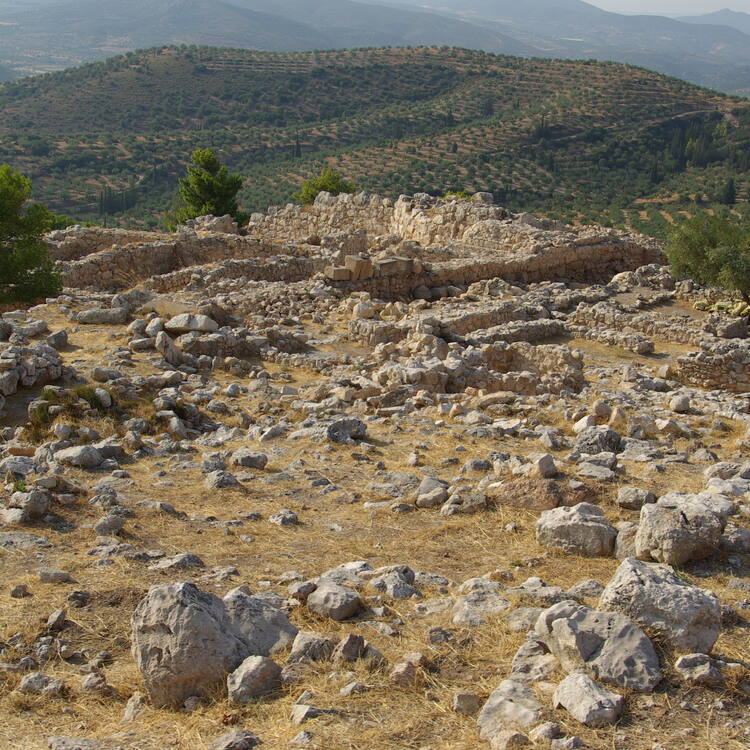
Outstanding Universal Value
Brief synthesis
The Archaeological Sites of Mycenae and Tiryns, located in the Regional unit of Argolis in the North-East Peloponnese, are the imposing ruins of the two greatest cities of the Mycenaean civilization, renowned for its technical and artistic achievements but also its spiritual wealth, which spread around the Mediterranean world between 1600 and 1100 BC and played a vital role in the development of classical Greek culture. The palatial administrative system, the monumental architecture, the impressive artefacts and the first testimonies of Greek language, preserved on Linear B tablets, are unique elements of the Mycenaean culture; a culture that inspired the great poet Homer to compose his famous epic poems.
The citadel of Mycenae, with its strategic position for the control of the Argolid Plain, is the kingdom of the mythical Agamemnon and the most important and richest palatial centre of the Late Bronze Age in Greece. Its name was given to one of the greatest civilizations of Greek prehistory, the Mycenaean civilization, while the myths related to its history, its rulers and their family members (such as Klytaimnestra, Ifigeneia, Elektra, Orestes) have inspired poets, writers and artists over many centuries, from the ancient to the contemporary times. Significant stages in monumental architecture are still visible in the property, such as the massive defensive walls, the corbelled tholos tombs and the Lions Gate.
Tiryns, situated 20 km north-east of Mycenae on a low hill near the inlet of the Argolic Gulf, is another excellent example of the Mycenaean civilization. The fortification of the hill, completed at the end of the 13th century BC, surrounds the citadel with a total perimeter of approximately 750 m. The impressive walls, built of stones even larger than those of Mycenae, are up to 8 m thick and 13 m high. They can rightly be regarded as a creation that goes beyond the human scale, as reveals the word “cyclopean” – built by Cyclops, the mythical giants from Lycia – which was attributed to them in the Homeric epics.
Criterion (i): The architecture and design of Mycenae and Tiryns, such as the Lion Gate and the Treasury of Atreus and the walls of Tiryns, are outstanding examples of human creative genius.
Criterion (ii): The Mycenaean civilisation, as exemplified by Mycenae and Tiryns, had a profound effect on the development of classical Greek architecture and urban design, and consequently also on contemporary cultural forms.
Criterion (iii): Mycenae and Tiryns bear unique testimony to the political, social and economic development of the Mycenaean world, thus representing the peak of this early stage of Greek civilization.
Criterion (iv) : Both sites illustrate in a unique manner the achievements of Mycenaean civilization in arts, architecture and technology, which laid the foundations for the evolution of later European cultures.
Criterion (vi): Mycenae and Tiryns are intricately linked with the Homeric epics, the Iliad and the Odyssey , which profoundly influenced European literature and arts for more than three millennia.
Both sites contain within their boundaries all the key attributes that convey their Outstanding Universal Value , bequeathing the spirit of the Mycenaean civilization from antiquity to the world of today. Their integrity is ensured primarily by the strict legal framework, which prohibits any construction within the boundaries of the sites and provides for the maintenance of the agricultural character of their surrounding area. Both sites are under the constant surveillance and monitoring of the Hellenic Ministry of Culture, Education and Religious Affairs. On-going archaeological research projects are conducted on both sites, aiming at further exploring the history and values of the property. These are carried out in a systematic way, taking into consideration all the international standards relating to archaeological fieldwork. The excavated monuments are building complexes or funerary monuments of big scale that are in a good state of preservation. Thus the integrity of the property is not compromised by the excavations, as all the necessary conservation interventions are simultaneously undertaken.
Authenticity
The authenticity of both sites is unquestionable. Monuments of Mycenae maintain their authenticity since the various restoration works carried out in the past were based on the international standards for the intervention on monuments, on archaeological evidence and on architectural remains of the Mycenaean period. Special studies based on the principle of reversibility have preceded all interventions.
The authentic character of the citadel of Tiryns is also well preserved. The interventions that took place during the 1950’s were mild and compatible to the original building system. Moreover, restoration works carried out in 1998-2005 were based on the original construction methods, thereby preserving all the architectural elements of the Mycenaean period.
Protection and management requirements
Both sites are protected under the provisions of the Greek Antiquities Law No 3028/2002, on the “Protection of Antiquities and Cultural Heritage in general”. The boundaries of the archaeological site of Mycenae and its buffer zone were established by Ministerial Decree No 2160 of 1964. Protection extends to the Citadel (Acropolis), the areas outside the walls and the wider surrounding area, including the natural environment of the site. The site of Tiryns is covered by Ministerial Decrees No 102098/4753 of 1956 and 12613/696 of 1991.
The property is under the jurisdiction of the Ministry of Culture, Education and Religious Affairs, through the Ephorate of Antiquities of Argolis, its competent regional service. In 1999, a scientific Committee for Mycenae was established, which carried out several projects of stabilization, conservation and enhancement of the site. Special attention was given to the accessibility of monuments by all visitors, and to other visitor’s facilities, such as an extensive network of pathways, stations and informative material.
The interpretation of the property is complemented by an archaeological museum, founded in 2003. Its collection comprises a great number of artefacts of Prehistoric and Historic times, giving special emphasis to the presentation of the Mycenaean period.
On both sites, systematic archaeological excavations are being carried out, while restoration works are conducted and others are scheduled. In Tiryns, the restoration project is jointly funded by the Greek state and the European Union. Restoration works in Mycenae, such as the restoration of the Tomb of the Lion, would further enhance the Outstanding Universal Value of the property, while the improvement of the network of ancient roads connecting Mycenae to other archaeological sites of the area (Heraion and Prosymna) would enhance our understanding of the broader area in antiquity.
- History Classics
- Your Profile
- Find History on Facebook (Opens in a new window)
- Find History on Twitter (Opens in a new window)
- Find History on YouTube (Opens in a new window)
- Find History on Instagram (Opens in a new window)
- Find History on TikTok (Opens in a new window)
- This Day In History
- History Podcasts
- History Vault
By: History.com Editors
Updated: June 20, 2023 | Original: March 26, 2018

Mycenae is an ancient city located on a small hill between two larger hills on the fertile Argolid Plain in Peloponnese, Greece. The Bronze-age acropolis, or citadel built on a hill, is one of the great cities of the Mycenaean civilization that played a vital role in classical Greek culture. Mycenae was also prominent in Greek mythology and inspired poets, writers, and artists throughout the centuries, though it was ultimately abandoned more than 2,000 years ago.
Mycenae in Greek Mythology
Mycenae’s true origins are unknown. According to Greek mythology , Perseus—son of the Greek god Zeus and Danae, who was the daughter of Acricio, the king of Argos—founded Mycenae. When Perseus left Argos for Tiryns, he instructed Cyclopes (one-eyed giants) to build the walls of Mycenae with stones no human could lift.
Perseus named the city Mycenae after the cap (myces) fell off his scabbard at the site, which he saw as a sign of good omen, or after finding a water spring to quench his thirst when he picked up a mushroom (myces) from the ground.
The Perseid dynasty ruled Mycenae for at least three generations and ended with the rule of Eurytheus, whom legends claim commissioned Hercules to perform the 12 labors. When Eurytheus died in battle, Atreus became king of Mycenae.
Mycenae is perhaps best known in mythology as the city of Agamemnon, the son of Atreus. King Agamemnon led the expedition against Troy during the Trojan War , which Homer accounted in his epic poem the Iliad .
Archaeological Site of Mycenae
Mycenae is situated in a naturally fortified position between the sloping hills of Profitis Ilias and Mount Sara, located some 20 km southwest of the Mycenaean city Tiryns. Mycenae and Tiryns were together recognized as UNESCO World Heritage sites in 1999.
The central feature of Mycenae—as with other Mycenaean citadels, including Tiryns and Pylos—is a great central hall called the megaron, which consisted of a columned porch, vestibule, and main chamber.
The megaron’s main chamber was a long rectangular room with a hearth in the center that’s surrounded by four columns supporting the roof. To the right of the hearth was a raised platform for the royal throne.
The megaron was surrounded by an irregular complex of buildings that included offices, archives, shrines, corridors, armories, storerooms, workshops, potteries, and oil-press rooms.
The massive “Cyclopean” walls of Mycenae also enclosed residential houses for aristocrats, various shrines, and Grave Circle A (so named by archaeologists), a stone funerary enclosure that contained massive shaft graves for the Mycenaean elite.
The citadel’s primary entrance was the Lion Gate, named for the lion sculpture that sits above it.
Outside the walls of Mycenae was the residential area of the city, Grave Circle B (which predates Grave Circle A) and various dome-shaped tholos (or “beehive”) tombs, including the famous Treasury of Atreus (or Tomb of Agamemnon ).
Development of Mycenae
Archaeological studies suggest the area of Mycenae was first occupied in the Neolithic Age dating back to about the 7th millennium B.C. But these early settlements left few records due to the site having continuous re-occupation up until the founding of the citadel.
The first families of rulers and aristocrats likely arose in the Mycenae area around 1700 B.C. during the early Bronze Age , as evidenced by the construction of Grave Circle B.
In 1600 B.C., inhabitants constructed Grave Circle A, the first tholos tombs, and a large central building.
The majority of the Mycenae monuments visible today were constructed in the late Bronze Age between 1350 and 1200 B.C., during the peak of the Mycenaean civilization.
The construction of the palace and city walls began around 1350 B.C. About 100 years later, Mycenaeans constructed the Lion Gate and its bastion, along with a new wall to the west and south of the original wall. This new fortification encompassed Grave Circle A and the city’s religious center.
On the heels of a destructive earthquake, the walls were extended to the northeast around 1200 B.C.
Mycenaean Civilization
In the Iliad , Homer aptly described Mycenae as “rich in gold.”
Mycenaeans enjoyed a prosperous rule over the Greek mainland and areas around the Aegean Sea, with the elite living in comfort and style, and the king ruling over a highly organized feudal system.
In Mycenae and other Mycenaean strongholds, workshops produced an array of both utilitarian and luxury goods, including weapons and tools, jewelry, carved gems, glass ornaments and vases, which likely transported oil, wine, and other commodities for trade.
What’s more, funerary artifacts unearthed at the Grave Circles were made of precious metals (gold, silver, and bronze) accentuated with precious stones and crystals.
Mycenaeans also likely engaged in mercenary wars and piracy, and they were known to periodically raid and loot the coastal towns of Egyptians and Hittites.
Fall of Mycenae
Mycenae and the Mycenaean civilization began to decline around 1200 B.C. Mycenae’s people abandoned the citadel around 100 years later after a series of fires.
It’s unclear what caused the destruction of Mycenae, though theories abound.
One of the leading theories holds that Mycenae underwent years of civil strife and social upheaval. Dorians and Heraclids then invaded, sacking all of the Mycenaean strongholds except Athens.
Mycenae may have further suffered at the hands of raiders from the sea.
Alternatively, Mycenae may have fallen to natural disasters, such as earthquakes, volcanic eruptions, drought or famine.
Whatever the case, though the citadel was abandoned, the outer city was not completely deserted and the remaining town was sparsely inhabited until the Greek Classical Period (5th and 4th centuries B.C.).
Destruction of Mycenae
During the Greek Archaic period (8th to 5th centuries B.C.), a temple dedicated to Hera or Athena was erected on the summit of the Mycenaean citadel.
Mycenae later took part in the Persian Wars, sending 80 men to the Battle of Thermopylae. Mycenae’s neighboring city Argos, which had remained neutral in the war, retaliated by conquering the town and destroying parts of its walls.
Sometime during the Hellenistic period —the period between Alexander the Great ’s death (323 B.C.) to the emergence of the Roman Empire (31 B.C.)—the people of Argos founded a village on the Mycenae hill, repaired some of the citadel’s walls and Archaic-period temple, and built a small theatre over the walkway to the tholos Tomb of Clytemnestra (Agamemnon’s wife).
At some point, however, the new village was subsequently abandoned. When the Greek geographer Pausanians visited the area in the 2nd century A.D., Mycenae had already been in ruins.
Excavation of Mycenae
In 1837, the Mycenae archaeological site came under the jurisdiction of the Greek Archaeological Society . Its representative, Greek archaeologist Kyriakos Pittakis, cleared the Lion Gate in 1841.
Heinrich Schliemann, a pioneer in archaeology, conducted the first excavations of Mycenae in 1874, uncovering five graves in Grave Circle A. Various archaeologists in the late 1800s and early to mid 1900s continued his work excavating the palace and cemeteries.
In the 1950s, George Mylonas of the Greek Archaeological Society led excavations of Grave Circle B and parts of the settlement outside of the Cyclopean Walls. Around the same time, members of the society restored the Tomb of Clytemnestra, the megaron, Grave Circle B, and the area surrounding the Lion Gate.
Further restorations continued in the late 1990s.
Excavations of Mycenae, particularly of the lower town outside of the citadel walls, continued in the 2000s. Surveys suggest the area holds hundreds of visible and buried structures, including tombs, houses and other buildings, guard towers and beacons, roads and highways, bridges and dams, and an outer fortification wall with three gates.
While many Mycenaean artifacts are exhibited at the National Archaeological Museum of Athens, the smaller Mycenae Museum next to the ancient citadel houses additional items discovered during archaeological digs in the surrounding site.
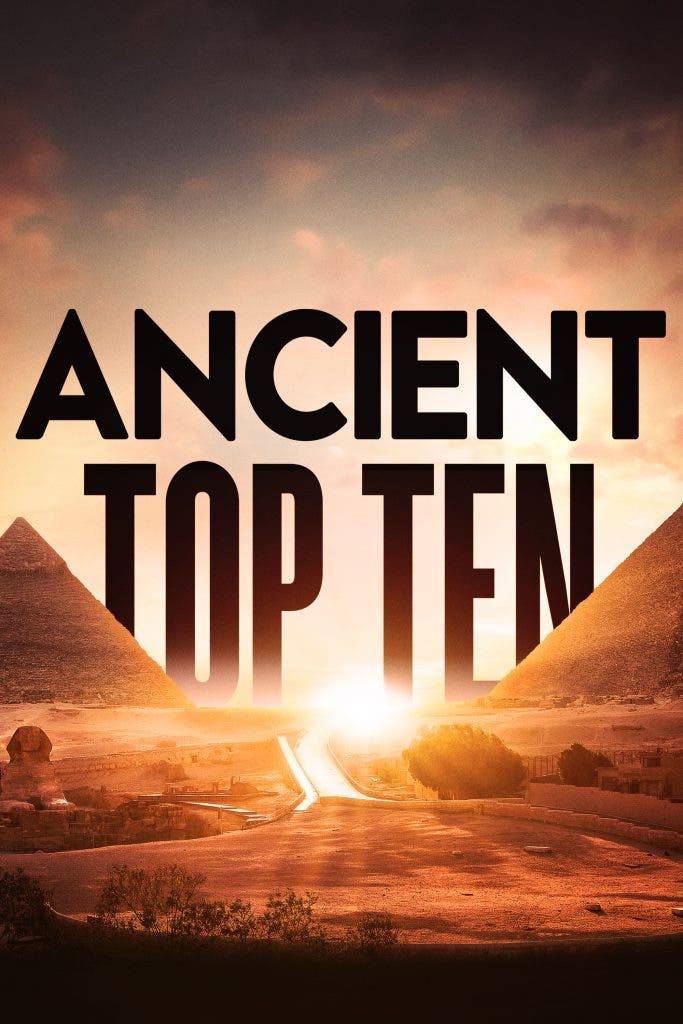
HISTORY Vault: Ancient Top 10
A smart, fun countdown that details how ancient technology worked, how surprisingly advanced it was, and how it was kind of awesome!
Mycenae; Ministry of Culture and Sports . Archaeological Sites of Mycenae and Tiryns; UNESCO . Pausanias. Pausanias Description of Greece with an English Translation by W.H.S. Jones, Litt.D., and H.A. Ormerod, M.A., in 4 Volumes. Cambridge, MA, Harvard University Press; London, William Heinemann Ltd. 1918. Mycenaean Civilization; METMuseum . Mycenae and Tiryns; Greek National Tourism Organisation . ABCs of Greek Architecture; The New York Times . Beyond the Walls of Agamemnon: Excavation of the Mycenae Lower Town (2007-2011); Dickinson Excavation Project & Archaeological Survey of Mycenae . Greek City’s End: New View Given; The New York Times Thomas R. Martin. An Overview of Classical Greek History from Mycenae to Alexander. Perseus Digital Library .

Sign up for Inside History
Get HISTORY’s most fascinating stories delivered to your inbox three times a week.
By submitting your information, you agree to receive emails from HISTORY and A+E Networks. You can opt out at any time. You must be 16 years or older and a resident of the United States.
More details : Privacy Notice | Terms of Use | Contact Us
%20(1).png)
Mycenae, Greece: Travel Guide
Introduction
Opening Hours
Parking and Toilets
What to See
My Other Blogs on Greece
1. Introduction
Mycenae is one of the most important archaeological sites of Greece. The period of Greek history from 1600 BC to 1100 BC was called the Mycenaean period because of its importance. At its peak in 1350 BC, the citadel and lower town had a population of 30,000 people.
It is a very popular and busy site. The main path from Lion Gate to the Citadel can look like Mount Everest on summit day! All groups stop at Lion Gate and are given a talk there. As a result Lion Gate becomes very congested and it is difficult to take photos.
It is important to time your visit so it doesn't coincide with the peak time of tour groups visits. It is best to arrive early or late in the day and this also avoids the summer heat.
In the mornings aim to arrive at opening time but by 09.00 at the latest. In the afternoon you should arrive after 17.00, the later the better. Parking will also be a lot easier.
2. Opening Hours at Mycenae
From 01.11.2022 to 31.3.2023 08:30-15:30
April : 08:00-19:00
02.05.2023 - 31st August 2023 : 08:00-20:00
1st September - 15th September : 08:00-19:30
16th September - 30th September : 08:00-19:00
1st October - 15th October : 08:00-18:30
16th October - 31st October : 08:00-18:00
Good Friday: 12.00-17.00 Holy Saturday: 08:30-15:30
Easter Sunday
25 December
26 December
3. Tickets for Mycenae
Tickets cost Eur 12 from April to October and Eur 6 from November to March.
There is free admission for children up to the age of 5, under 25's and students. However, students and under 25's have to reside in the EU. You must provide documentary proof.
Admission is free on the following days:
The last weekend of September.
Every first Sunday from November 1st to March 31st.
4. Parking and Toilets
There is a car park which is usually full with buses. You can park along the road but at peak times you may have a problem finding a parking place.
5. What to See at Mycenae
It would take about 1.5 to 2 hours to see everything at the site including the museum. It all depends on your level of interest in ancient Greece.
The main sights to see are:
Mycenae is fortified with Cyclopean walls of huge irregular stones and has two triumphal entrances. The larger entrance is the Lion's Gate and it was built around 1400-1300 BC. The heads of the lions are missing, but they would have faced frontally to fulfill their role as guardians of the entrance.

The Cyclopean Walls
Mycenae's Cyclopean walls are the most famous example of Cyclopean masonry. The term derives from the mythical Cyclopes. He was believed to be the one who built them as only he would have had the strength to move such huge boulders.
There are good views of the Cyclopean walls to the right of Lions Gate, before entering it. Very few people come here.

Grave Circle A
Grave Circle A is a 16th-century BC royal cemetery. The burial complex was initially constructed outside the walls of Mycenae. It was later enclosed in the acropolis when the fortification was extended during the 13th century BC.
A total of nineteen men, women, and children were buried here. Among the funerary gifts found were several gold death masks, full sets of weapons, ornate staffs, gold jewelry, as well as gold and silver cups. It has been estimated that Circle A contained about 15 kilos of gold.

The Royal Palace
The palace is in a central location atop the citadel and was the main building within the fortified walls. The state rooms were arranged around a central court which led to the Megaron (a grand reception hall).
The ruins are only at ground level but you can distinguish what was a great court, the throne room, the megaron and the royal apartments.

The Royal Tombs
There are 3 spectacular royal tombs outside the walls of Mycanae. We found them to be the most interesting thing after Lion Gate. They aren't busy like the rest of the archaeological site.
The Tomb of Aegisthus
The Tomb of Aegisthus is among the earliest examples of Tholos Tombs. It was built of small stones in the early 15th century BC.
Aegisthus organized the assassination of Agamemnon along with his mistress. There is no evidence that Aegisthus was buried in this tomb.
Tour groups usually just look down into the tomb and don't bother to go down and enter it. It is worth doing so.

The Tholos Tomb of Clytemnestra
Nearby is the Tholos Tomb of Clytemnestra, the legendary wife of Agamemnon. Its name implies that Clytemnestra was buried in it but there is no such evidence. The tomb was looted by Veli Pasha during the Ottoman rule, but otherwise is in excellent condition and shows exceptional masonry craftsmanship.
When we visited we had the tomb to ourselves!

The Treasury of Atreus
The Treasury of Atreus is four hundred metres down the road from the main site. It was built between 1350 and 1250 BC and is the best preserved Tholos tomb.
It's an architectural masterpiece displaying the high level of craftsmanship reached by the Bronze Age masons. The entire monument is constructed with exceptionally well cut stones.
The tomb was never buried by earth and always remained visible throughout the centuries. It was robbed in antiquity and there is no indication of who was buried there. Its function as the tomb of Atreus, the father of Agamemnon, is by no means certain.

The entrance to the archaeological site includes the museum. It contains many valuable items excavated from this site. Unfortunately the gold masks found in Grace Circle A by Schliemann, the archaeologist, aren't here. There is a copy of one.

6. My Other Blogs on Greece
Monemvasia, Greece: Travel Guide
Tiryns, Greece: Travel Guide
Epidaurus, Greece: Travel Guide
Nafplio, Greece: Travel Guide
Corinth, Greece: Travel Guide
Delphi, Greece: Travel Guide
The Monasteries of Meteora: Travel Guide
Naxos, Greece: Travel Guide
Mystras, Greece: Travel Guide
Tinos, Greece: Travel Guide
Syros, Greece: Travel Guide
Andros, Greece: Travel Guide
North Macedonia to Greece - Week 4
Nafplio, Greece to the Peloponnese - Week 5
Peloponnese to the Greek Islands - Week 6
The Greek Islands - Week 7
The Greek Islands to Albania - Week 8
Recent Posts
Comentários.
Plan Your Trip to Mycenae: Best of Mycenae Tourism
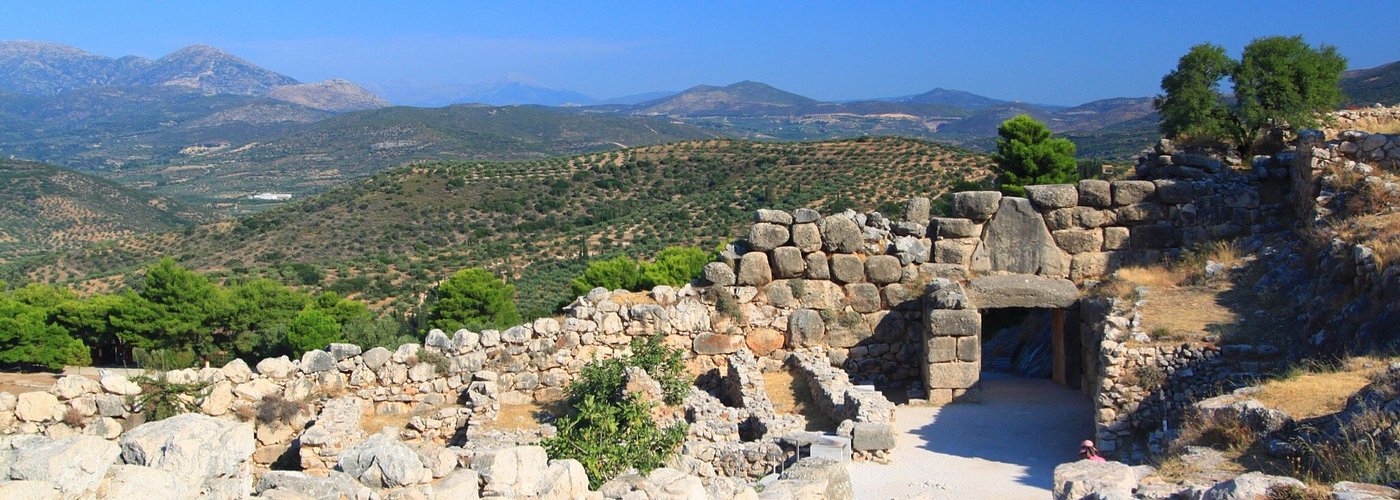
Essential Mycenae

- Kolizeras Restaurant
- King Menelaos Restaurant
- La Belle Helene de Menelas Restaurant
- Agamemnon Palace
- Archaeological Site Mycenae
- Citadel and Treasury of Atreus
- Archaeological Museum of Ancient Mycenae
- Mycenae Taxi Tours
- Explore the Acropolis & Museum Private Tour with a Local Guide
- Self-guided Virtual Tour of Mycenae: In the bath with Clytemnestra
- Mycenae Archaeological Site & Agamemnon Tomb Skip-the-Line Ticket
- Mycenae Entrance e-ticket with Audio Tour on Your Phone
- Mycenae Archaeological Site Admission Ticket

Visit Mycenae Greece
Introduction, times and prices, essential places to visit, 1. the lions gate, 2. the tomb of agamemnon, 3. the palace of mycenae, useful information, 1. how to get there from athens, 2. available travel circuits, 1. how long does it take to visit mycenae, 2. are guide services available in mycenae.
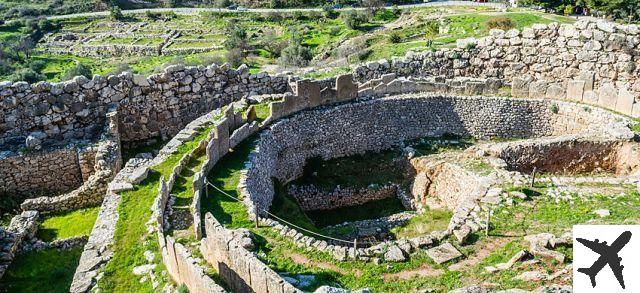
Welcome to our article about visiting Mycenae, one of the most fascinating destinations in Greece. In this article, you will find all the information you need to plan your visit, including schedules, prices, essential places to visit, useful information, how to get there from Athens and available travel routes. Get ready to discover the magic of Mycenae!
If you are planning to visit Mycenae, it is important that you know the opening hours and entrance prices. The archaeological site of Mycenae is open every day of the week, from 8:00 am to 8:00 pm. The entrance price is 12 euros for adults and 6 euros for students. Children under 18 years old enter free. Remember that these prices may vary, so we recommend checking the updated information before your visit.
Mycenae is famous for its impressive archaeological ruins, dating back to the Bronze Age. Some of the essential places that you cannot miss during your visit are:
The Lion Gate is one of the most recognizable symbols of Mycenae. This imposing gate is the main entrance to the city and is decorated with two lions sculpted in stone. It is a perfect place to take photographs and immerse yourself in the history of ancient Greece.
The Tomb of Agamemnon is another essential place to visit in Mycenae. This tomb is believed to have been built for the legendary King Agamemnon, leader of the Greeks in the Trojan War. Although the tomb is empty, its architecture and decoration are impressive.
The Palace of Mycenae is the heart of the ancient city and is one of the most important sites from an archaeological point of view. Here you can explore the remains of the palace buildings, walls and warehouses. Don't miss the panoramic view from the top of the palace.
Before your visit to Mycenae, it is important to keep in mind some useful tips:
If you are in Athens, you can reach Mycenae by car or bus. The distance between the two cities is approximately 120 kilometers and the trip by car takes around 1 hour and 30 minutes. If you prefer to take the bus, there are several companies that offer regular services from Athens to Mycenae.
If you want to explore beyond Mycenae, there are several travel circuits that include this destination. Some of the most popular circuits are the Peloponnese tour, which will take you through the main archaeological sites in the region, and the Classic Greece circuit, which combines Mycenae with other iconic places such as Athens, Delphi and Olympia.
The time needed to visit Mycenae may vary depending on your interests and the pace of your visit. In general, it is recommended to spend at least half a day exploring the archaeological site and nearby places. If you want to delve deeper into the story and enjoy every detail, you may need more time.
Yes, in Mycenae you will find guide services available for those who wish to gain a deeper insight into the history and archeology of the place. The guides are experts in the field and can provide you with additional information and answer your questions. You can hire a guide at the entrance to the archaeological site.
We hope this article has provided you with all the information you need to plan your visit to Mycenae. From entry times and prices to must-visit places, we've covered all the important aspects. Don't forget to check the updated information before your visit and make the most of this unique experience in ancient Greece. We wish you an unforgettable trip to Mycenae!
Until next time,
The fortravelovers.com team
Related Items
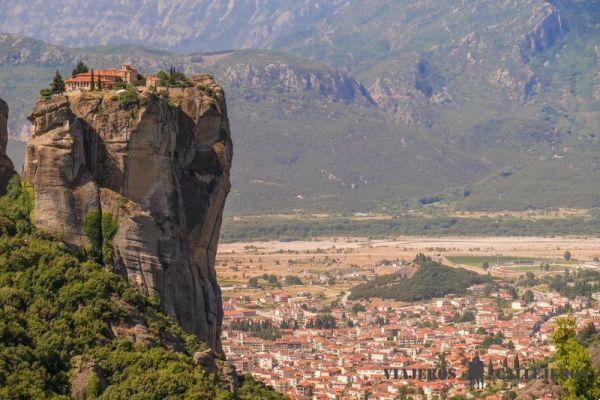
How to get from Athens to Meteora
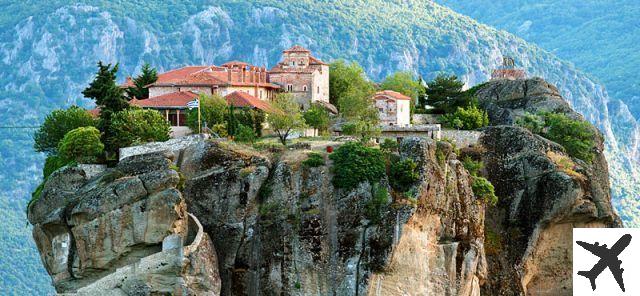
Visit meteora monasteries greece
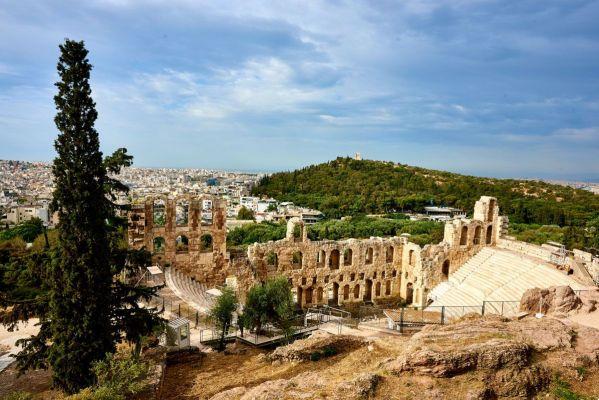
Best free Athens free tours
Add a comment of visit mycenae greece, content for you.
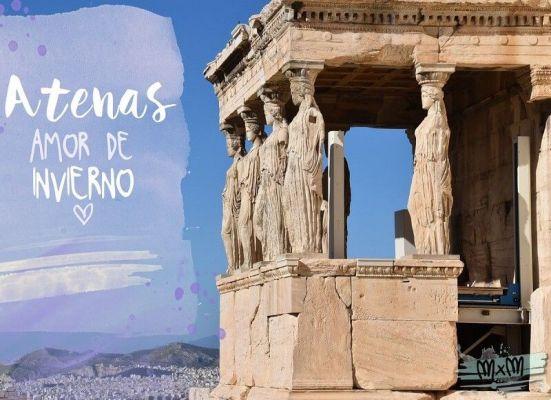

- Top Attractions
Mycenae was one of the most thriving towns of ancient Greece . It was the most important city of the Mycenaean civilization between 1600 and 1100 BC.
Nowadays, Mycenae is an impressive archaeological site in the region of Argolis, 120 km southeast of Athens . It is believed that during the Roman Empire, Mycenae was a relevant touristic destination.
What to see in Mycenae
The main gateway to the citadel of Mycenae is the most iconic symbol of this archaeological site. The Lion Gate was built in 1250 BC and measures 3 meters wide by 3 meters high . The main entrance is crowned by two large lions that also measure approximately 3 meters each.
Once you get to the main entrance, we suggest you look at the markings on the floor and the bolt holes to get an idea of how large the gate once was.
Treasury of Atreus
The German archaeologist Heinrich Schliemann discovered the Treasury of Atreus during the nineteenth century. He was also responsible for revealing Mycenae in 1874 and spent most of his career trying to unearth Troy and demonstrate the existence of Agamemnon.
Erected approximately in 1250 BC, the circular monument was a large tomb for the Mycenaean royal family. It's even believed that the remains of Agamemnon, King of Mycenae, lie here.
Grave Circle
As well as the Treasury, six circular tombs were discovered to the south of the Lion Gate. The remains of nineteen people were found in the tombs .
Schliemann and his team found numerous relics, some made of gold, displayed in the National Archaeological Museum in Athens.
How to get to Mycenae from Athens?
Discover the best ways to get to Mycenae from Athens:
Reserve an excursion
Booking an excursion in English is the most comfortable way to discover Mycenae. We have both day tours and circuits.
- Corinth, Mycenae, and Epidaurus Day Trip
- 3-Day Classical Greece Tour
- Classical Greece Tour: 4 Days
Renting a car is the most popular option , especially if you plan to explore Greece at your own leisure. Click on this link to compare the best car rentals in Greece.
It's quite easy to get to Mycenae from Athens. Take the highway to Corinth and head in the direction of Tripoli . Once you have passed Corinth, continue about 15 miles and then take the exit to Nafplio . You'll then see the exit to Mycenae on this road. It takes approximately two hours from Athens .
The coaches that run between Athens and Nafplio stop in Mycenae . Depending on the season, you can either take a bus or walk to the archaeological site.
All coaches depart from Terminal A (100 Kifissou) once an hour, between 7:30 am and 7:30 pm. The journey takes just over two hours.
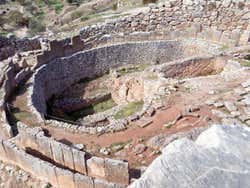
120 km southeast of Athens.
Nearby places
Corinth (31.8 km) Epidaurus (37.7 km)
You may also be interested in
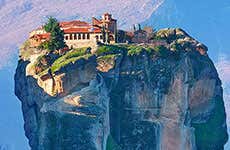
Situated in the center of Greece, Meteora is a large rock home to breathtaking monasteries. It is one of the most special places in Greece.
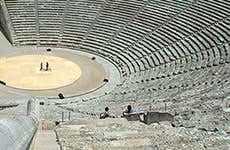
Epidaurus is a small ancient Greek sanctuary on the Argolid Peninsula. It is famous worldwide for its spectacular ancient theatre (currently still in use).
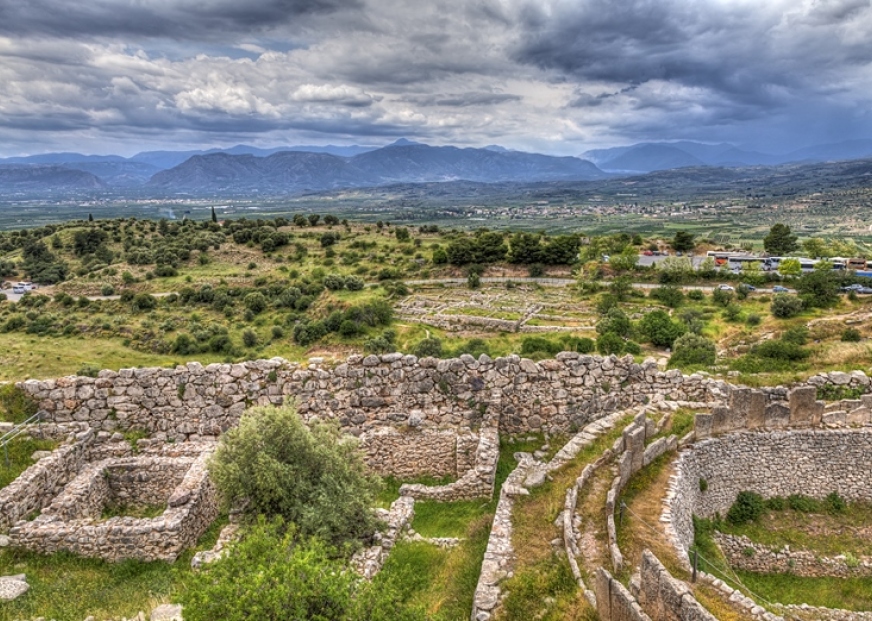
Article by www.museummasters.gr/en/
Other interesting articles

Ζorba the Greek project - The Village

Complete guide to Florina, the "alpine" city of Greece with sublime nature
Mycenae, a Tale of Glory
Key Takeaways
- Mycenae was a thriving city during the Mycenaean civilization, which flourished from around the 16th to the 12th century BCE.
- The impressive Cyclopean walls were constructed using massive limestone blocks, creating a fortress-like appearance and showcasing the advanced engineering skills of the Mycenaeans.
- The Lion Gate is the main entrance to the citadel of Mycenae. It is adorned with two large lion relief sculptures and is considered an iconic symbol of the city .
- Excavations in Mycenae have unearthed a wealth of artifacts, including intricately designed gold jewelry, pottery, weapons, and religious objects, all of which one can admire in the Archaeological Museum of Mycenae .
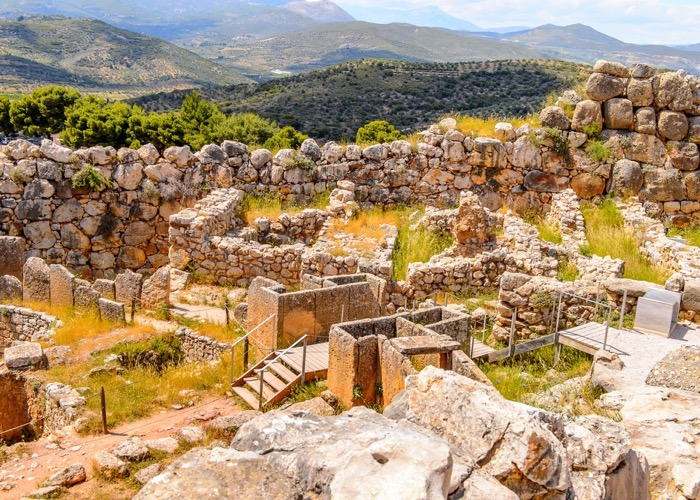
Mycenae , the ancient city that named a whole civilization after itself, lies in the low hillsides of Peloponnese close to the modern town of Argos in mainland Greece . Set on a trip traveling you back thousands of years and discover monuments so ancient that even ancient Greeks considered them ruins of antiquity.
Mycenae stretches across some kilometers northern to the city of Argos on the top of a low hill that overlooks the valley stretching until the shores of the Argolic Gulf .
Built on a naturally fortified location, the Acropolis of Mycenae is the first thing the visitor sees by the time he sets foot in the region.
Huge stone blocks were put in to create an impenetrable wall for the protection of the “ Anax ” and his people, Mycenae was for sure one of the most progressive and impressive places of prehistoric Greece .
Therefore, you should definitely not miss the chance to visit the birthplace of Agamemnon while in Greece and relive the history of Mycenae through the words of the most revered poet of them all, Homer .
Τhe history of Mycenae
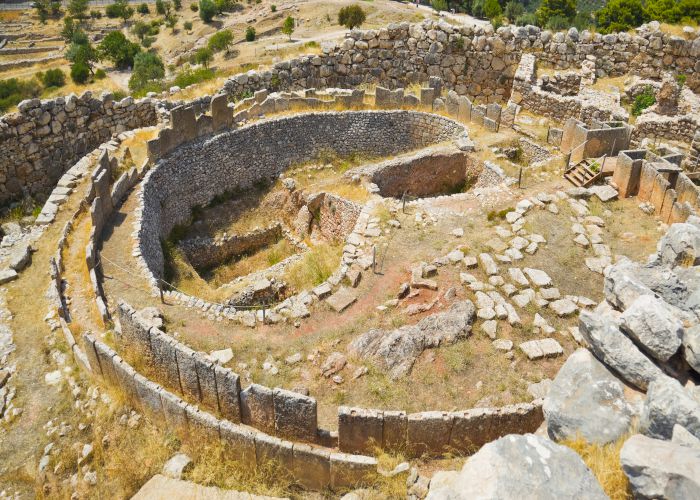
Although archaeologists have resulted in the fact that the location of Mycenae was inhabited since Neolithic times , the main settlement of Mycenae and the richest palatial centre developed after the coming of the first Hellenic tribes at the beginning of the second millennia BC.
The idea that even during that time period, a well-organized settlement with a distinct social hierarchy and significant production existed is proven by the discovery of much archaeological material and, more impressively, by the findings of the graves of approximately that period most likely belonging to the ruling class of Mycenae.
Even the very word 'Mycenae' has a questionable etymology. It is so old that scholars still debate its origins, although most of them agree on the fact that it should be pre-Hellenic and that it has to do with the location of the settlement.
During the next centuries, the population of Mycenae steadily increased, creating an urban center with an elaborate trading network, covering a wide geographical area and operating as a key role player in the politics of that time period.
In the 14th century BCE, the wealth of Mycenae was such that its acropolis was fortified with a wall built with colossal stone blocks . Even ancient people of the classical times, not being able to understand how their ancestors surpassed the technological difficulties of such endeavor, named these walls Cyclopean , believing that the mythical Cyclopes were responsible for their creation.
The famous Lion Gate
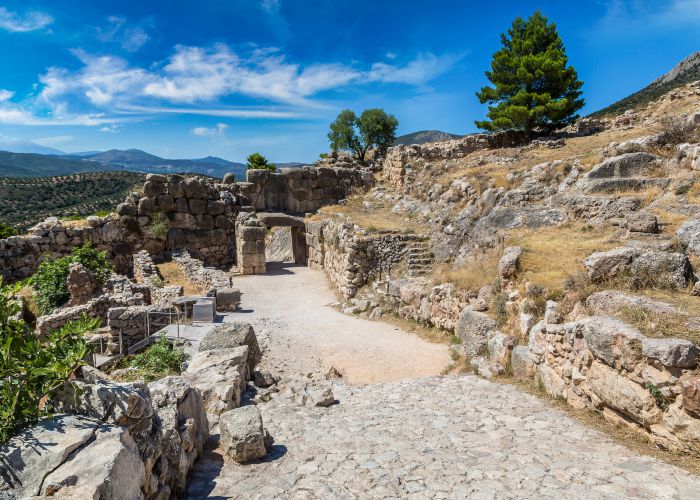
The walls of Mycenae expanded over the next century, and one of the entrances was decorated with a relief of two lions placed heraldically on an altar. This entrance is now known as the Lions Gate , an attraction of Mycenae since antiquity.
Except for its significance in Greek history, the relief of the lions in the Lion Gate in Mycenae is perhaps the earliest example of monumental sculpture to be found in mainland Europe as well.
Behind the massive walls of the Acropolis of Mycenae, people could find shelter and protection in times of need, and it was also the place where the ruling class of Mycenae used to live.
Right after the Lion Gate, today’s visitor passes by the ruins of Grave Circle A , a location of royal burials, some of them dated as far as 1600 BCE, and later Grave Circle B.
The Mycenaean civilization

When the Cycladic and Minoan civilizations were at their peak, a new people, the Achaeans, came from the north and settled in central and southern Greece. These are the first Greeks.
The Achaeans got to know the Cycladic and Minoan civilizations and were impressed. They learned many things from the Cyclades and the Minoans and created their own culture, called the Mycenaean civilization.
It took its name from Mycenae, located in the Peloponnese, and was the largest center of this culture. Other Mycenaean centers were Thebes, Orchoienos, Athens, Iolkos, Pylos, Sparta, Tiryns.
The Mycenaeans or Achaeans, having as an example the Minoans, also became merchants. With their ships, they traveled all over the Mediterranean and reached Egypt, Palestine, and Cyprus.
They also occupied Crete, which, after the eruption of the volcano of Thera and the destruction of its cities, had lost its great power.
Later the Achaeans campaigned against Troy. The location of Troy was very important for trade. That is why the Achaeans wanted to conquer it and build their own trading post there.
The Trojan city, as we have learned, lasted ten years. The Achaeans conquered Troy, after which they slowly began to lose their power.
The German explorer Henry Schliemann was the first to make excavations and discover Mycenae, the Mycenaean citadel, and, therefore, the Mycenaean civilization, which is an integral part of the cultural heritage of Greece.
The development of Mycenae
The solid economic base of Mycenae was agriculture and animal husbandry.
At the same time, from a very early age, and with the palace as a regulating factor, various craft branches were developed. Stonework and metallurgy are some of the fields in which Mycenae was distinguished.
However, the greatness and radiance of Mycenae are mainly due to the development of shipping and trade. Especially from the middle of the 15th century BC, when the Mycenaeans occupied Knossos, the Greek Mycenaean element gradually dominated the sea and spread to the Mediterranean.
Such a maritime spread could not always be peaceful. The Trojan War echoed the overseas military operations of the time. The elements that united the various Greek races during the Mycenaean era were many. In general, it was the same as those that united the Greeks of historical times.
The first and strongest should be considered the common language - testified by the oldest Greek texts in Linear B - as well as the common religion and posthumous beliefs, as they can be detected through burial customs and practices. An additional cohesive element of Mycenae was the uniformity in the socio-political organization and the institutions.
As a natural result of the above ties and through the continuous transactions between the various Mycenaean centers, a single culture was created, the culture of the Mycenaean common.
Strictly hierarchical Mycenaean society resembles a pyramid, at the top of which was the anax. He, together with his family, lived in the palace, the center of power in each territory. The various courtiers and the priesthood followed in the hierarchy.
The inhabitants of each area were the municipalities. The municipalities were numerous and organized in villages around the administrative center and the palace. In addition to farmers and stockbreeders, the signs with text in Linear B provide us with an inexhaustible range of skilled craftsmen.
After taking over Crete in 1450 BC, Mycenae became a sea emperor. The Mycenaeans established colonies and trading posts throughout the Aegean and on the coasts of Asia Minor.
At the same time, in search of raw materials and markets, they traveled to the Near East, southern Italy, Sicily, and Spain and had sporadic contact with Central and Northern Europe.
They systematically colonized Cyprus and came in contact with the Hittite state. The Hittite records call the Mycenaeans Achiyava (Achaeans) and emphasize that their kingdom is a measurable naval power.
The fall of Mycenae and the Mycenaean civilization
In about 1200 BC. there was a sudden decline in Mycenaean power. Palaces, citadels, and settlements in Mycenae were destroyed. At the same time, Linear B disappeared.
We do not know exactly the reasons that caused this disaster. What actually happened in the Mycene remains unknown though theories abound.
According to some theories, Mycenae experienced many years of civil conflict and social upheaval. Dorians and Herclids invaded and sacked all Mycenaean cities except Athens. Raiders may have also impacted Mycenae. Mycenae may have been wiped out by disasters such as earthquakes, eruptions, or drought.
During the ancient Greek archaic period (7 to 5th centuries BC), an Athenian Temple was built on the summit of Mycena. Mycenae also served in the Persian Wars and sent 80 soldiers to Thermopylae. Argos, Mycenae's neighbor, remained silent during the conflict and retaliated and conquered the city, and destroyed some sections of its walls.
Other scholars attribute it to the movement of new Greek tribes, such as the descent of the Dorian, others to internal unrest, and others, finally, to the terrible unrest that prevails at this time in the eastern Mediterranean basin, with the fall of the Hittite state and the attacks of the so-called "peoples of the sea" against Egypt.
This upheaval resulted in the fall of the Mycenaean trade and the gradual decline of the Mycenaean palaces due to the economic crisis. In reality, the decline of Mycenae is due to a combination of all reasons listed above.
The Mycenaean civilization lost its power but did not collapse completely. Many elements of it survived and were transmitted to the next phase of Greek culture.
The Archaeological Site of Mycenae
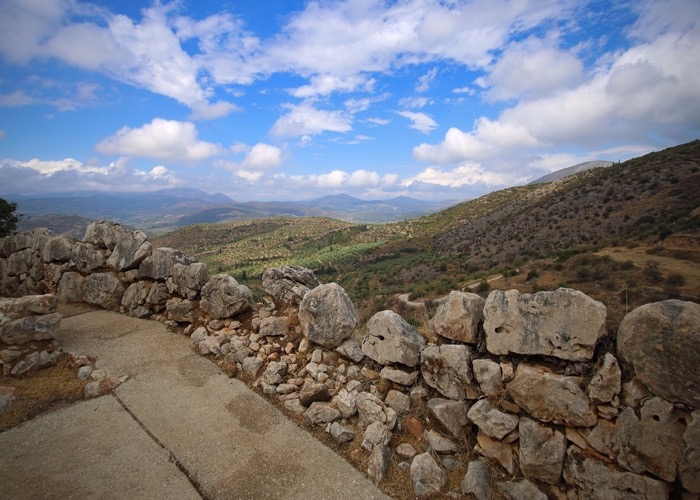
The archaeological sites of Mycenae and the Tyryns have been listed as UNESCO World Heritage Sites since 1999.
The famous archaeology enthusiast Heinrich Schliemann, after his excavations on the site of Troy , shifted his attention to Mycenae following the stories of Homer’s Iliad and the work of Pausanias . He arrived in the region and started excavating the area where he unearthed the peribolos and grave shafts of Grave Circle A.
Luckily, the tombs of Mycenae that date back to the Late Bronze Age had not been stripped from their offerings during antiquity; therefore, he was able to collect an unimaginable amount of treasures. As a result, he discovered one of the most well-preserved and important archaeological sites of classical Greek culture.
Some of them are the Golden Mask of Agamemnon , the Golden cup of Nestor , the Silver Siege Rhyton, and the plethora of jewelry , ornamented weapons, and personal items of exquisite craftsmanship using priceless materials.
Continuing up the grand road of the archaeological site after the Lion Gate, the visitor finds himself at the premises of the Mycenaean palace , located close to the highest point of the Acropolis. Known as the megaron , the palatial structure was the seat of the ruler with large halls decorated with vividly colored frescoes.
The very central point of the megaron was the throne room, where the ruler would sit on an elevated throne in front of a burning hearth. Most probably operating as the reception room, its decoration was there to impress foreigners and to provoke awe and respect in the subjects.
Some examples of the frescoes found at the megaron of Mycenae can be found at the National Archaeological Museum in Athens, which is the most important archaeological museum in the country, and where other significant pieces of the archaeological site are also preserved.

As luxurious as the lives of the ruling class might have been, it is certain that they also thought about their lives beyond death, something that became apparent from the funerary artifacts unearthed.
Huge megastructures were built to host the burials of more than one member of the royal family the individuals belonged to.
Known as tholos tombs , these structures were, and still are, a feat of engineering, and the site of Mycenae has nine of those examples, more than most archaeological sites. The most well-preserved and well-known tholos tombs, though, are the Treasury of Atreus and the Tholos of Clytemnestra .
The Treasury of Atreus, or the Tholos of Agamemnon as H. Schliemann named it, was built in ancient Greece around 1250 BCE. Despite its double name, scholars agree on the fact that probably another person was initially buried in the structure.
The monument was described by Pausanias, the traveler of the 2nd century AD, and its location was known throughout the centuries. The Mycenaeans used a technique called corbelling in order to create a huge space with no additional support to its dome, holding up massive amounts of dirt since it is buried as a tumulus.
The Treasury of Atreus has a diameter of about 14.5 meters, and it used to be the largest space covered with a dome until the creation of the temple of Hermes in Baiae and the Pantheon in Rome!
Its lavish decoration and sculptural ornamentation have survived in a fragmentary state, but they surely give us an idea of the splendor and scale of the building.
Another Grave Circle located outside of the walls of Mycenae and its Lion Gate provided the archaeologists with more information about this long-gone civilization and filled the gaps that the research conducted by H. Schliemann left in the history of Mycenae.
More archaeological sites of Mycenae and lavish buildings with spectacular frescoes, shrines, temples, and a big residential area are some of the things you are going to witness during your trip to the birthplace of Agamemnon. People continued to live at the glorious ruins of Mycenae until Hellenistic times.
In classical times, the accounts inform us that the Mycenaeans contributed to the Persian Wars by participating in the battles of Thermopylae and Plataea .
Although this new town was much smaller in scale, it had many public buildings incorporated into the much older, still operating shrines of the past. A temple at the Acropolis of Mycenae was built as well.
Mycenae in Greek Mythology
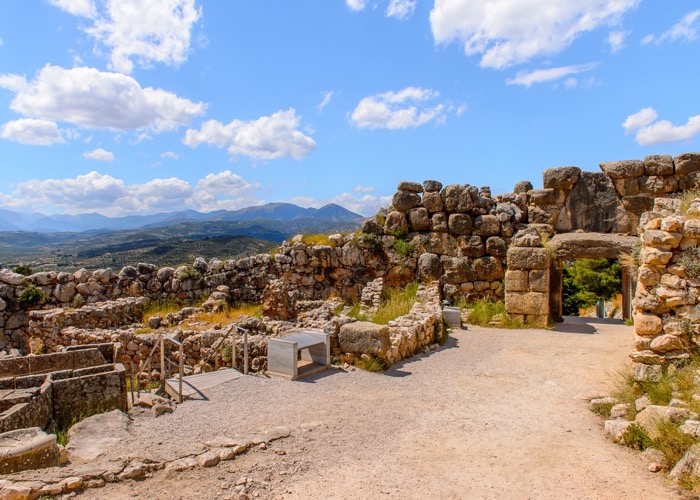
According to Greek Mythology, the founder of the Mycenaean kingdom was the hero Perseus. When his last descendant, King Eurystheus, the one who defined the deeds of Hercules, lost his life, the people voted for a new king, Atreus.
Atreus's brother, Thyestes, seduced his wife to usurp the throne, and the king took revenge on Thyestes by killing his two sons and serving them to him. Thyestes then cursed Atreas and his house never to find prosperity.
The successors of the house of Atreus were Agamemnon and Menelaus. Agamemnon inherited the kingdom of Mycenae, and Menelaus became the king of Sparta. The two brothers married two sisters, Clytemnestra and Eleni, respectively.
Legend has it that the three goddesses Hera, Athena, and Aphrodite competed to see who was the most beautiful, with the winner being the prince of Troy, Paris. Each tried to bribe him to be chosen by the prince.
Aphrodite promised him if he won, the most beautiful woman in Greece, who was the beautiful Eleni -the wife of Menelaus-. With the help of the goddess, the beautiful Eleni followed Paris to Troy, thus making Menelaus, in revenge, declare war on the Trojans.
Thus began the famous Trojan campaign. Menelaus, with the help of his brother Agamemnon and the Greek kings, marched to Troy.
On the occasion, when the throne was empty, Aegisthus, the son of Thyestes, found the opportunity and approached Agamemnon's wife, Clytemnestra. With her help, he took power and reigned with her for ten years, and they had three children.
As soon as he returned, Agamemnon from Troy, Clytemnestra, and Aegisthus were killed. Orestes, son of Agamemnon, wanting to avenge the unjust death of his father, killed his mother and her lover and seized power.
Orestes then married Hermione, daughter of Menelaus and Helen, and so the kingdoms of Mycenae and Sparta were united.
After some time, the descendants of Hercules, called Heraclides, came and overthrew the king, and thus, the cycle of the Atreides ended in misery.
Final Thoughts
Mycenae is for sure a place of wonder, and its Acropolis still captivates the imagination of the people reflecting on stories of war and glory.
Put Mycenae, this UNESCO World Heritage Site, on your bucket list, plan your own visit there, or check out one of our Greece tours , and soon you'll be passing through the Lion Gate into a world of wonder!
Frequently Asked Questions
How was mycenae destroyed.
Recent studies have found that ancient Mycenae may have crumbled because of rebellion or invasion. However, the Greek archaeological society doesn't have a definitive answer to this question.
Historically, most of what was thought about the collapse of the Mycena civilization was the idea that devastating earthquakes sank the Peloponnesian civilization and its archaeological sites around 1,200 B.C. and damaged the city of Mycena.
Was Mycenae the first Greek state?
Yes, the civilization that developed in mainland Greece during the Late Bronze Age (1600-1100 BC) was the first great Greek civilization. Its name was invented by archaeologists from the most important center of the time, Mycenae.
What is Mycenae known for apart from its archaeological sites?
Mycenae has been widely described in mythological times as Agamemnon's city, the son of Atreus. King Agamemnon led an expedition to destroy Troy in the Trojan War, whose account was recorded in the Iliad, a Greek mythical poem by Homer.
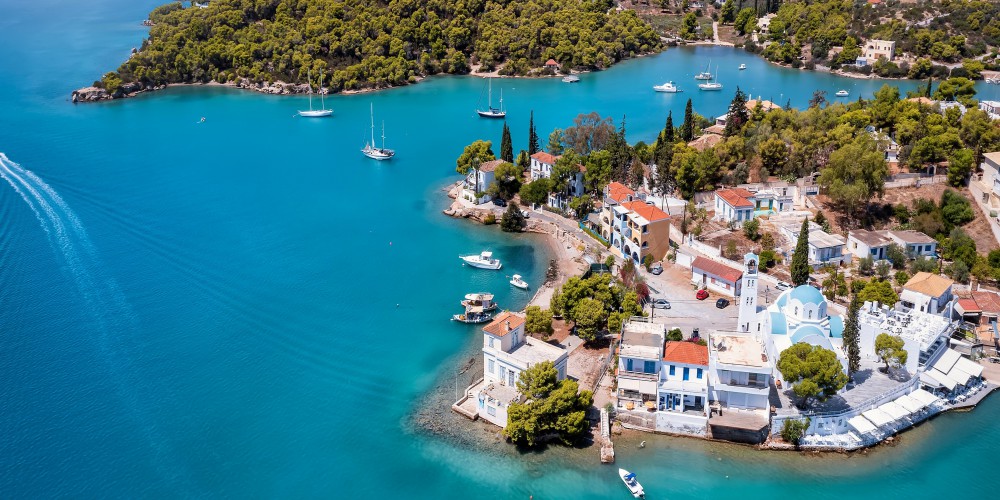

10 Most Interesting Historic Sites In Greece & The Amazing Stories Associated With Them
- Greece is home to some of the most famous historic sites in the world, such as Knossos, the Temple of Poseidon, and the Acropolis of Athens.
- These ancient sites in Greece have fascinating backstories, like the legend of the Minotaur at Knossos and the belief that Poseidon was the master of the sea.
- Exploring these historic ancient Greek sites allows visitors to immerse themselves in the rich history and culture of Greece, from the ruins of ancient civilizations to the religious sanctuaries and breathtaking natural scenery.
Greece is an incredible place full of history and culture. Home to one of the world's oldest civilizations, this country is revered as the birthplace of Western civilization. Today, it is jammed with some of the most historic sites in the world, such as those on this list, which come with interesting stories and date back several hundred and even many thousands of years ago.
Visiting these top ancient sites in Greece is an exciting activity for any history lover, and the adventure becomes even more intense when one is armed with the stories behind them. These are among the best historic sites in Greece to visit, along with each place's amazing backstory.
Related: 10 Five-Star-Rated Activities For First-Timers Visiting Greece
Knossos is a historic site on the island of Crete, which served as the center of the famous Minoan civilization. This site was excavated in the 19th century to reveal many ruins of ancient civilizations and hidden treasures, including the grand Knossos palace and its complex network of rooms and hallways.
The palace complex also houses the throne room of Minos, former king of Crete, magnificent pillars, and captivating frescoes. It is believed to be the palace where the legend of the Minotaur, Theseus, and Ariadne took place.
Knossos is also said to be the oldest city in Europe , which is one more reason it is worth visiting.
- Location: Near Heraklion, Crete, Greece
The Temple Of Poseidon
The Temple of Poseidon is one of the most fundamental monuments of the golden age in Greece. The temple was dedicated to Poseidon - the Greek god of the sea, and it sits on the headland of Cape Sounion, Greece, overlooking the sea and Patroklos Island in the distance.
The temple was built between 444 and 440 BC, and it was particularly important as the city of Athens depended on trade by sea to thrive, and the Athenians believed Poseidon was the master of the sea.
- Location: Cape Sounion, Greece
Related: 10 Best Museums To Check Out While In Greece
Epidaurus is an ancient site in the Peloponnese most famous for its massive well-preserved ancient theater, which was constructed in the 4th century BC. The theater was established to host religious events dedicated to the god Asclepius, the Greek god of medicine.
Beyond the theater, Epidaurus also features the temple of Asclepius and other healing sanctuaries where people from all over the ancient world gathered to get healed of their ailments.
- Location: Argolis region, Greece
The theater at Epidaurus is still in use today, as it hosts the annual Athens and Epidaurus Festival held in summer.
Located in the Peloponnese region of Greece (home to many historic places) , Olympia is an iconic town with a significant sports history. The archeological site was where the Olympic Games originated, which were held every four years from the 8th century until 394 AD when the Roman Emperor Theodosius I ended the tradition.
The site was dedicated to the Olympian god, Zeus, and the games were held in honor of the deity. Today, the site is home to some of the best ruins in Greece; it is filled with ruins of the refurbished stadium used for the games, tombs, and temples.
- Location: Northwestern Peloponnese
Mystras is an iconic UNESCO World Heritage Site atop a hill overlooking Sparta. The site was built by William II of Villehadouin, prince of Achaea, in the 13th century, and it served as a center of Byzantine intellectualism until it fell to the Ottoman Empire in 1460 AD.
Today, it is home to several impressive Byzantine ruins, which include a fortress, palace, monasteries, and churches.
- Location: Laconia, Peloponnese, Greece
Meteora combines interesting history with stunning natural scenery and religious significance. The site is famous for its many imposing rocks and cliffs where several Meteroa monasteries dating back centuries are precariously positioned , symbolizing the strong relationship between the Greeks and religion.
The monasteries were established by monks who wanted isolation between the 13th and 14th centuries, and it's difficult not to marvel at the stunning sights when visiting.
- Location: Near Kalambaka, Thessaly
Philippi is an impressive ancient city in Greece established in 360 BC as a colony of Thassos and conquered in 356 BC by Philip II of Macedon, the father of Alexander the Great, who named it after him.
Religious enthusiasts will find this site inspiring and insightful, as it was the city where Paul the Apostle first preached on European soil.
- Location: Filippoi, Macedonia region, Greece
From Greece and Cyprus to Turkey and Israel, travel in the footsteps of Paul the Apostle by visiting the sites he once did .
Related: For History Buffs: Top 10 Archeological Sites To Visit In Greece
Mycenae is an ancient city and one of the earliest Greek civilizations that existed between 1700 BC and 1100 BC. The city, which is situated in the Argolis region of the Peloponnese, prospered during the Bronze Age and became renowned in Ancient Greece as a city of fierce warriors and great engineers.
Today, it is one of the best archeological sites in Greece and is filled with ruins of some architectural masterpieces like the Lion Gate and the Treasury of Atreus. One of the most remarkable sites here is the tomb of the former famous king, Agamemnon, who led the Greeks to war against Troy.
- Location: Argolis, Northeast Peloponnese, Greece
Delphi was the most popular religious sanctuary in the ancient Greek world . This religious site was where kings, demi gods, soldiers, and ordinary people from Greece and beyond came to hear the words of the gods from the mouth of the oracle of Delphi.
The sanctuary was dedicated to the god Apollo, and today, it has been designated a UNESCO World Heritage Site and boasts the ruins of the Temple of Apollo, a theater, a gymnasium, and some other important structures from ancient Greek times.
- Location: Phocis, Central Greece
The Acropolis Of Athens
The Acropolis of Athens is unrivaled as one of the most famous historic sites in Greece (perhaps the most recognizable). Imposing its height on the capital, Athens, this elevated and fortified citadel is always a spectacle for first-time visitors and locals alike.
Atop the Acropolis are ancient remnants of the golden age in Greece, showing how resourceful, creative, and extraordinary the ancient Greek civilization was even without technology. Some of the structures on this site include - the Parthenon, the Erechtheum, and the temple of Athena Nike. Formerly used for defense and the worship of gods, the site is now a tourist attraction that leaves visitors in awe of the ancient Greek world.
The Acropolis has so many stories that surround it, and one of the most popular is how the goddess Athena defeated the sea god Poseidon to become the patron goddess of the city .
- Location: Athens, Greece
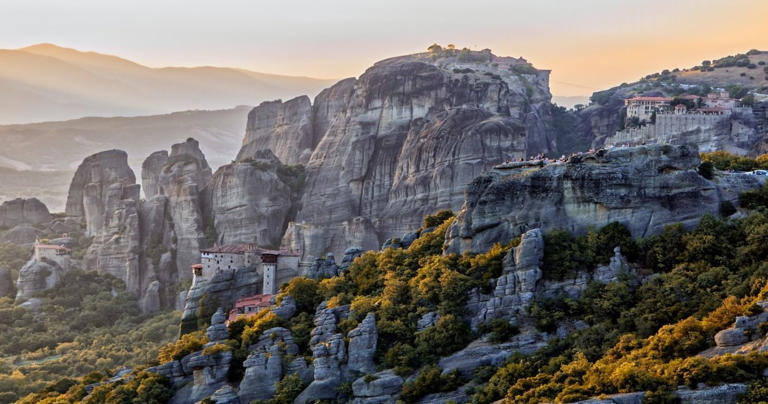
How to get to Mycenae?
Travel to Mycenae, Greece: Mycenae is known as one of the most valuable archaeological sites in Greece, therefore you really need to drop a visit here, especially if you are a lover of ancient history! On this page, you will find out in which ways you can reach and explore this wonderful destination! Don't forget to get informed about the local transportation options you have, in order to organize your transfer to your hotel and explore Mycenae easily!
Day tours from Athens
Discover some day tours to Mycenae from Athens and grab the chance to learn everything about one of the most significant archaeological sights in Greece! > Discover our tours!
KTEL buses link Mycenae with Nafplion, Argos and Athens. You can find more specific information about timetables and itineraries on www.ktelargolida.gr .
In order to reach Mycenae from Athens by car, you need to drive through the Greek National Road from Corinth to Tripolis. After the Corinth canal, you need to follow the route towards Nafplion and Mycenae. The distance between Athens and Mycenae is about 130 km. In case you don't have your own vehicle, it is an excellent idea to hire one for your sightseeing trips! > Rent your car to Mycenae from Athens!
Flights near Mycenae
There is no airport in Mycenae. The most convenient airport is the International Airport of Athens, which operates all year round and receives internal and international flights. From Athens, visitors can go to Mycenae by bus or rental car.
DISCOVER MORE ABOUT MYCENAE
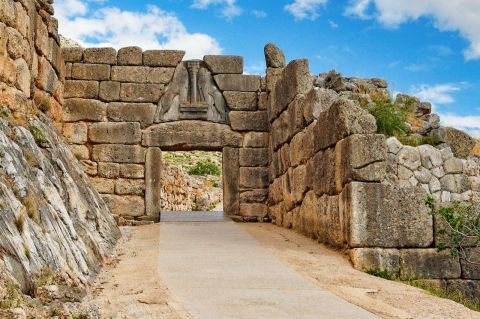
OUR TRAVEL SERVICES IN MYCENAE

Do you Need a Free Travel Quote?
Our team of experienced travel specialists can organize your unforgettable vacation in Greece!
Please send us a request and we will rapidly answer you with a free quote!
- Share this page on Facebook
- Share this page on Twitter
- Copy the URL of this page

IMAGES
VIDEO
COMMENTS
Tours, Tickets, Trips & More. Book Now - Selling Fast. Free Cancellation Policy.
If you're visiting independently, it's probably worth double checking that the Mycenae site is open before you rock up! During the winter period, Mycenae is open from 8.30-15.30. During the summer period, the hours are: April-August: 08:00-20:00. 1st September-15th September : 08:00-19:30.
The decline of Mycenae occurred around 1100 BC, possibly due to repeated damage from earthquakes and fires. They had managed, however, to have once been a truly great empire, which has indelibly stamped its reputation on the history not only of Greece, but the entire world.The archaeological site of Mycenae is 140km from Athens and 24km from ...
The Mycenae Lion Gate is the only Bronze Age monument still surviving in Greece and it stands at the entrance to the greatest citadel of the Ancient Mycenaens. Here's everything you need to know about how and why to visit, what to see, and where to stay.See the Grave Circles, the Treasury of Atreus (the Tomb of Agamemnon), and the spectacular Lion Gate, only 120 kilometers from Athens and a ...
If you're coming from Nafplio, there is this one direct bus to and from Mycenae each day (leaving Nafplio at 09:30 and returning from Mycenae at 12:00). However, the easiest way to get to Mycenae from Athens is by car, and the drive will take about two hours. (If you need to rent a car, I recommend using Discover Cars in Greece.)
Mycenae is among the most important archaeological sites in Greece. It is located on the eastern side of Peloponnese, close to Nafplion Town, and can be easily visited for a day trip from Athens. According to mythology, this was the town of the legendary king Agamemnon, the leader of the Greeks during the Trojan War.
The Archaeological Site of Mycenae Greece. Mycenae in Peloponnese Greece is a spectacular UNESCO-listed monument. The site contains the remains of a magnificent prehistorical fortified Palace and vaulted tombs of immense cultural significance for world history. Mycenae used to be the powerful financial and administrative center of the Mycenean ...
29. Cultural Tours. Explore the remains of the ancient city of Mycenae a major center of Greek civilization from 1600BC to 1100BC and a world heritage monument. Continue on to Epidaurus and visit the ancient theater. The UNESCO'S world heritage listed monument is reputed to be the birthplace of Apollo's son Asklepios.
The archaeological sites of Mycenae and Tiryns are the imposing ruins of the two greatest cities of the Mycenaean civilization, which dominated the eastern Mediterranean world from the 15th to the 12th century B.C. and played a vital role in the development of classical Greek culture. These two cities are indissolubly linked to the Homeric ...
Mycenae (/ m aɪ ˈ s iː n iː / my-SEE-nee; Ancient Greek: Μυκῆναι or Μυκήνη, Mykē̂nai or Mykḗnē) is an archaeological site near Mykines in Argolis, north-eastern Peloponnese, Greece.It is located about 120 kilometres (75 miles) south-west of Athens; 11 kilometres (7 miles) north of Argos; and 48 kilometres (30 miles) south of Corinth.The site is 19 kilometres (12 miles ...
Mycenae is an ancient city located on a small hill between two larger hills on the fertile Argolid Plain in Peloponnese, Greece. The Bronze-age acropolis, or citadel built on a hill, is one of the ...
Ancient Site of Mycenae. Located in eastern Peloponnese, the archaeological site of Mycenae is among the most important places in mainland Greece. Even mentioned by the epic poet Homer and the geographer Pausanias, Mycenae was the most powerful town of its days and even gave its name to an entire historical period, the Mycenaean period.
The Mycenaean civilization, who appeared around 1700 B.C., was indeed to dominate Greece during more than four centuries. The importance of Mycenae was such that the city even gave its name to a whole period of Greek history at the end of the Bronze Age: the Mycenaean period, from 1600 to 1200 BC.
Mycenae — a fortress city atop a hill — was the hub of a mighty civilization that dominated the Greek world between 1600 and 1200 BC, a thousand years before Athens' Golden Age. A visit to Mycenae is a trip back into prehistory to see some of the oldest remains of a complex civilization in all of Europe. Following the same ancient sandal-steps as the ancient Greeks, today's visitors ...
Contents1. Introduction 2. Opening Hours 3. Tickets 4. Parking and Toilets 5. What to See 6. My Other Blogs on Greece 1. IntroductionMycenae is one of the most important archaeological sites of Greece. The period of Greek history from 1600 BC to 1100 BC was called the Mycenaean period because of its importance. At its peak in 1350 BC, the citadel and lower town had a population of 30,000 ...
We recommend checking out these popular tours when looking for something to do in Mycenae: Explore the Acropolis & Museum Private Tour with a Local Guide; Self-guided Virtual Tour of Mycenae: In the bath with Clytemnestra; Mycenae Archaeological Site & Agamemnon Tomb Skip-the-Line Ticket; Mycenae Entrance e-ticket with Audio Tour on Your Phone
If you want to explore beyond Mycenae, there are several travel circuits that include this destination. Some of the most popular circuits are the Peloponnese tour, which will take you through the main archaeological sites in the region, and the Classic Greece circuit, which combines Mycenae with other iconic places such as Athens, Delphi and ...
Corinth, Mycenae, and Epidaurus Day Trip; 3-Day Classical Greece Tour; Classical Greece Tour: 4 Days; By car. Renting a car is the most popular option, especially if you plan to explore Greece at your own leisure. Click on this link to compare the best car rentals in Greece. It's quite easy to get to Mycenae from Athens.
The archaeological site of Mycenae is securely located between two hills and the grassy plain of Argos stretches before this ancient city. Mycenae was the most important city in the Greek peninsula during the late years of the Bronze Age and gave its name to one of the most pioneering civilizations of this era: the Mycenaean civilization. According to a legend, Perseus was the founder of ...
ancient Greece. Mycenae, prehistoric Greek city in the Peloponnese, celebrated by Homer as "broad-streeted" and "golden.". According to legend, Mycenae was the capital of Agamemnon, the Achaean king who sacked the city of Troy. It was set, as Homer says, "in a nook of Árgos ," with a natural citadel formed by the ravines between ...
Mycenae Sights & Attractions. Famous from myths and legends, Mycenae was a strong military town and gave its name to an entire era, the Mycenaean times. Discovered in the late 19th century, Mycenae is famous for its Cyclopean Walls, the Treasury of Atreus and the Lion Gate. These three are the most famous site in the archaeological site of Mycenae.
Key Takeaways. Mycenae was a thriving city during the Mycenaean civilization, which flourished from around the 16th to the 12th century BCE.; The impressive Cyclopean walls were constructed using massive limestone blocks, creating a fortress-like appearance and showcasing the advanced engineering skills of the Mycenaeans.; The Lion Gate is the main entrance to the citadel of Mycenae.
Mycenaean Greece (or the Mycenaean civilization) was the last phase of the Bronze Age in ancient Greece, spanning the period from approximately 1750 to 1050 BC. It represents the first advanced and distinctively Greek civilization in mainland Greece with its palatial states, urban organization, works of art, and writing system. The Mycenaeans were mainland Greek peoples who were likely ...
Related: For History Buffs: Top 10 Archeological Sites To Visit In Greece. Mycenae . Mycenae is an ancient city and one of the earliest Greek civilizations that existed between 1700 BC and 1100 BC ...
Travel to Mycenae, Greece: Mycenae is known as one of the most valuable archaeological sites in Greece, therefore you really need to drop a visit here, especially if you are a lover of ancient history! On this page, you will find out in which ways you can reach and explore this wonderful destination! Don't forget to get informed about the local transportation options you have, in order to ...